Billion Electric BIL-2073N-R Wireless-N HomePlug AV200 Ethernet Adapter User Manual Use s Manual
Billion Electric Co., Ltd. Wireless-N HomePlug AV200 Ethernet Adapter Use s Manual
Use's Manual
Wireless-N HomePlug AV 200
Wall Plug Ethernet Adapter
User Manual
Last revised April 2009
Safety Warnings
Do not use the adapter in high humidity or high temperature environment.1.
Do not open or repair the case yourself.2.
Avoid using this product and all its accesories outdoor.3.
Place the adapter on a stable surface.4.
Only “HomePlug AV” compliant Powerline Communication (PLC) adapter for remote access is 5.
necessary.
Plug your HomePlug AV device directly to the AC outlet on the wall. It is best to avoid using 6.
extension power cable as it may possess noise lter or surge protector functions that may
cause interference that may impact the performance of the device.
FCC Statement
This equipment has been tested and found to comply with the limits for a Class B digital device, pursuant to
Part 15 of the FCC Rules. These limits are designed to provide reasonable protection against harmful
interference in a residential installation.
This equipment generates, uses and can radiate radio frequency energy and, if not installed and used in
accordance with the instructions, may cause harmful interference to radio communications. However, there
is no guarantee that interference will not occur in a particular installation. If this equipment does cause
harmful interference to radio or television reception, which can be determined by turning the equipment off
and on, the user is encouraged to try to correct the interference by one of the following measures:
Reorient or relocate the receiving antenna.
Increase the separation between the equipment and receiver.
Connect the equipment into an outlet on a circuit different from that to which the receiver is connected.
Consult the dealer or an experienced radio/TV technician for help.
To assure continued compliance, any changes or modifications not expressly approved by the party
responsible for compliance could void the user's authority to operate this equipment.
(Example - use only shielded interface cables when connecting to computer or peripheral devices).
Changes or modifications not expressly approved by the party responsible for compliance could void
the user's authority to operate the equipment.
This equipment complies with FCC RF radiation exposure limits set forth for an uncontrolled environment.
This device and its antenna must not be co-located or operating in conjunction with any other antenna or
transmitter.
“To comply with FCC RF exposure compliance requirements, this grant is applicable to only Mobile
Configurations. The antennas used for this transmitter must be installed to provide a separation distance
of at least 20 cm from all persons and must not be co-located or operating in conjunction with any other
antenna or transmitter.”
Table of Contents
Chapter 1: Product ............................................................................1
Introduction .................................................................................1
No sweat to set up an in-home network ..............................................1
Extended Wireless Coverage ..............................................................1
Smooth trafc and prioritization ...........................................................1
Immune to noise and intervention .......................................................1
Features ......................................................................................2
Quality of Service Control ...................................................................2
Wireless LAN ......................................................................................2
Specications ..............................................................................3
Chapter 2: Installing the Adapter .....................................................4
Package Content.........................................................................4
Device Overview ......................................................................... 5
Hardware Installation ..................................................................6
Connecting the HomePlug Adapter .............................................8
Power Connection ...............................................................................8
LAN Connection ..................................................................................8
Networking Setup ................................................................................9
Quick Start (Setup Powerline Network) .....................................10
Push Button usage ............................................................................10
Application Scenarios .......................................................................10
Powerline Network Illustration ...........................................................12
Chapter 3: Basic Network Installation ..........................................13
Network Conguration ...............................................................14
Conguring PC in Windows Vista......................................................14
Conguring PC in Windows XP .........................................................16
Conguring PC in Windows 2000 .....................................................17
Conguring PC in Windows 95/98/Me...............................................18
Conguring PC in Windows NT4.0 ....................................................19
Factory Default Settings ............................................................ 20
Internet Access Conguration ................................................... 21
Conguring with your Web Browser ..................................................21
Chapter 4: Conguration ................................................................22
Status ........................................................................................ 23
Status ................................................................................................23
Statistic .............................................................................................25
Internet Setting ..........................................................................26
LAN ...................................................................................................26
Wireless Settings ......................................................................28
Basic Wireless Settings.....................................................................29
Wireless Security/Encryption Settings ..............................................32
Secuirty Mode ................................................................................................. 33
Advanced Wireless Settings .............................................................35
Wi-Fi Protected Setup .......................................................................36
Station List ........................................................................................38
Power Line Settings ..................................................................39
Status ................................................................................................39
Privacy ..............................................................................................40
QoS ...................................................................................................41
Administration ........................................................................... 45
System Management ........................................................................45
Firmware Upgrade ............................................................................46
Settings Management .......................................................................47
Chapter 5: Troubleshooting ............................................................48
1
Chapter 1: Product
Introduction
Thank you for purchasing this Wireless-N HomePlug AV 200 Wall Plug Ethernet Adapter. Your new
device is an unit that extends your wireless coverage through power lines.
Compliant with the latest HomePlug AV standards, which support data speeds of up to 200Mbps,
the device can be used to bridge Ethernet devices such as modems, routers, PCs, set-top-boxes,
and game consoles, allowing users to share network access via existing in-home power cabling.
What's unique is that the device has an extra built-in 802.11n Access Point, enabling users to
enjoy mobility, high-speed wireless connection and better coverage with no more dead zones. Just
plug the device into any wall power socket, and you can easily set up a secure wireless network
by pressing the Wi-Fi Protected Setup (WPS) button. Thus, the adapter can extend your wireless
coverage through power lines for multimedia applications such as online games, IPTV and audio
streaming from room to room..
No sweat to set up an in-home network
The HomePlug Adapter does not require the time and money needed to install expensive Ethernet
cables throughout your house in order to share your home network. Nor does it require any
drilling. Just one touch of the “Sync” button to install the bridge utility and your high-speed network
is ready. It’s as easy as simply plugging in your networking devices and using the electrical wiring
in your home.
Extended Wireless Coverage
With an integrated Draft-802.11n Wireless Access Point, the adapter can bridge wireless
connections of up to 6 times the speed and 3 times the wireless coverage of an 802.11b / g
network device. It supports a data rates up to 300Mbps and is also compatible with 802.11b / g
equipment. The Wireless Protected Access (WPA-PSK / WPA2-PSK) and Wireless Encryption
Protocol (WEP) features enhance the level of transmission security and access control over
Wireless LAN. The device also supports the Wi-Fi Protected Setup (WPS) standard, allowing
users to establish a secure wireless network by simply pushing a button.
Smooth trafc and prioritization
Quality of Service control guarantees the transmission quality by automatically prioritizing data.
The device automatically recognizes the bandwidth needs of voice and video applications. QoS
prioritizes the data to guarantee optimal transmission quality. TV and video images are received
and displayed with absolute smoothness. QoS also guarantees clear, instant transmission of voice
data, even when other applications are running on the network at the same time. QoS makes your
network a pleasure to use.
Immune to noise and intervention
Unlike others, the device supports superior and noise-immune data transmission over in-home
electrical power lines. Even at the moment your family turns on an electronic device or turns off a
light, you won’t experience any interruption to latency-sensitive applications such as multimedia or
video being shared with your family in another room.
Features
Provides physical layer data rate of up to 200Mbps over existing in-home power lines•
Extended wireless coverage of up to 3 times the range of 802.11g products•
WPS (Wi-Fi Protected Setup) for easy setup•
Auto channel select•
Utilizes power line technology that takes advantage of the unused bandwidth of the electrical •
wiring in your home
Utilizes Quality of Service control•
Supports Triple Play applications such as IPTV, VoIP and high-speed Internet access•
Supports 10/100 BaseT Ethernet•
Compliant with the HomePlug Powerline Alliance industry specications•
Ideal for residential users•
Quality of Service Control
Enhancements: contention-free access, four-level priority based contention access, and multi •
segment bursting
ToS, CoS and IP Port Number Packet Classiers•
Supports IGMP managed multicast sessions•
IGMP snooping with multicast to multiple unicast support in CSMA•
QoS classication for quasi-error-free delivery - VLAN priority eld, ToS Field•
Enhanced IPv4/IGMPv1-3 snooping support•
Supports IPv6 and MLDv1-2 snooping•
Wireless LAN
Compliant with IEEE 802.11n, 802.11g and 802.11b standards•
2.4 GHz–2.484 GHz frequency range•
Auto channel select•
Up to 300Mbps wireless operation rate•
WPS (Wi-Fi Protected Setup) for easy setup•
64/128 bits WEP supported for encryption•
Wireless Security with WPA-PSK/WPA2-PSK support•
2

Specications
Protocol TDMA, CSMA/CA
Standard Ethernet specication: IEEE 802.3, IEEE 802.3x, IEEE 802.3u,
Auto MDI/MDIX
Transmission Speed 200Mbps
Modulation Supports OFDM - 1155 carriers,1024 / 256 / 64 / 16 / 8 QAM,
QPSK, BPSK and ROBO
Frequency Band 2MHz ~ 30MHz
Security 128-bit AES Link Encryption with key management for secure
power line communications
Encryption: NMK (Network Membership Key) used to authenticate/
access
Rotating NEK (Network Encryption Key)
Operating System Windows 98 / 98SE / Me / 2000 / XP / Vista
Other 10/100 Base-T Ethernet devices
Power Supplier Input: 100~240V AC, 50~60Hz
Protection: OCP, OVP, SCP
Physical Interface AC power plug
2 xed antennas
WPS button
Sync button
Reset button
RJ-45 compatible
LED display:
WLAN•
POWER•
PLC (Powerline Link/Act)•
ETH (Ethernet Link/Act)•
Physical Specications Dimensions (W, D, H): 4.42” x 3.05” x 2.12” (112.4mm x 77.4mm x
53mm)
Operating Environment Operating temperature: 00C ~ 400C
Storage temperature: -200C ~ 700C
Humidity: 20 ~ 95% non-condensing
3
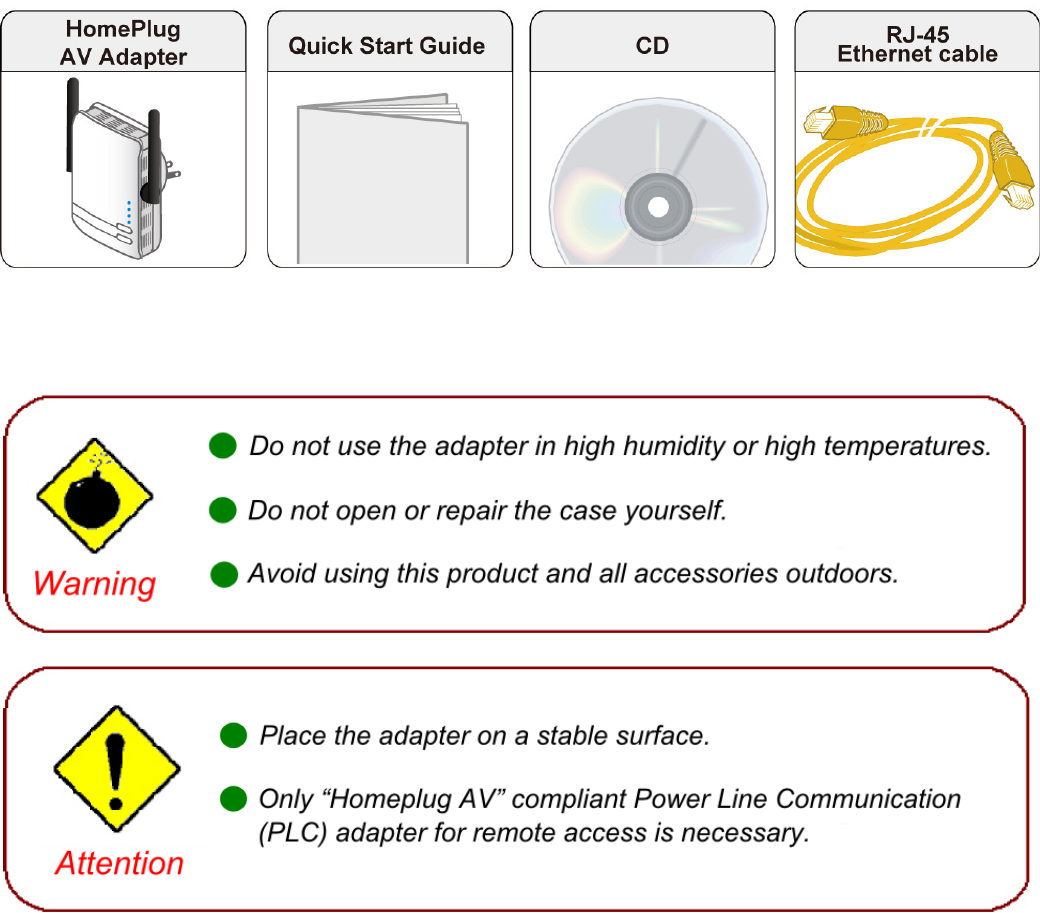
Chapter 2: Installing the Adapter
Package Content
Wireless-N HomePlug AV 200 Ethernet Adapter •
Quick Start Guide•
CD (containing user manual and QSG)•
Ethernet (CAT-5 LAN) cable•
4
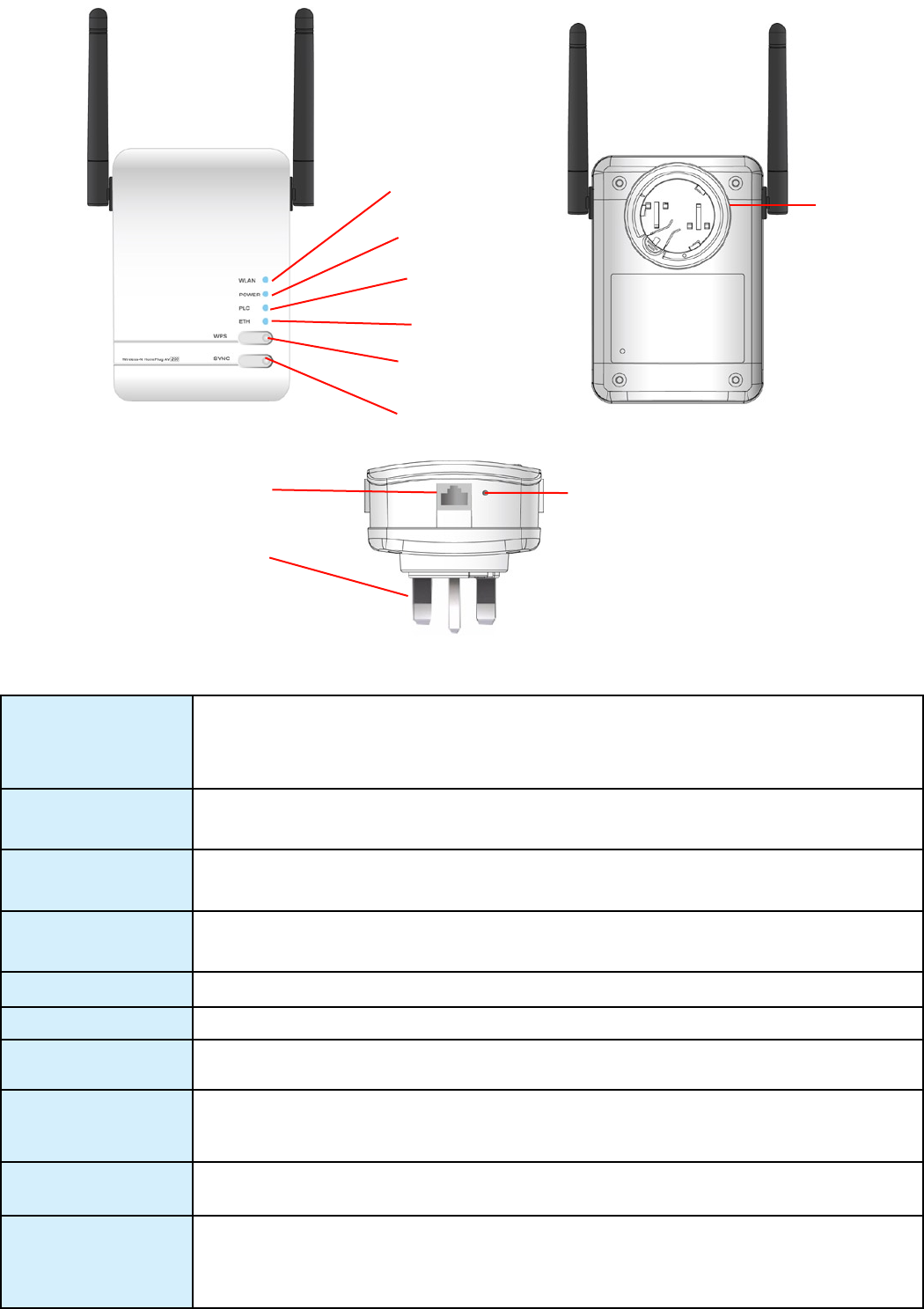
5
Device Overview
The Description of each labeled part is described in the table below.
WLAN LED Lit green when the wireless function is enabled.
Blinking when data is transmitted or received.
Blinking quickly when WPS is proceeded.
Power LED Lit green when the device is power on.
Lit off when power is off.
PLC (Powerline
Link/Act) LED
Lit green when the power line sync is established.
Blinking when networking is active.
ETH (Ethernet
Link/Act) LED
Lit green when connected to an Ethernet device.
Blinking when data is transmitted or received via Ethernet port.
WPS Button Push this button to trigger Wi-Fi Protected Setup function.
Sync Button Used to establish a LAN network with other power line devices.
Reset Button Press this button more than 2 seconds to reset device to factory default
settings.
Ethernet Port Connect the HomePlug AV device with an Ethernet device (e.g. computer,
router, hub/switch, IP pone, IPTV set-top-box, gaming consoles…), using the
RJ-45 Ethernet cable included.
Power Plug / AC
Power Cord
Plug into an AC outlet for power supply and to build a powerline network with
other HomePlug AV devices.
Clip Socket Install the clip into this socket.
Note: Please DO NOT remove or disassemble the socket clip frequently
as this may cause serious damage to your HomePlug AV device.
WLAN LED
Power LED
PLC LED
ETH LED
WPS Button
SYNC Button
Ethernet Port
Power Plug
Reset Button
Clip Socket
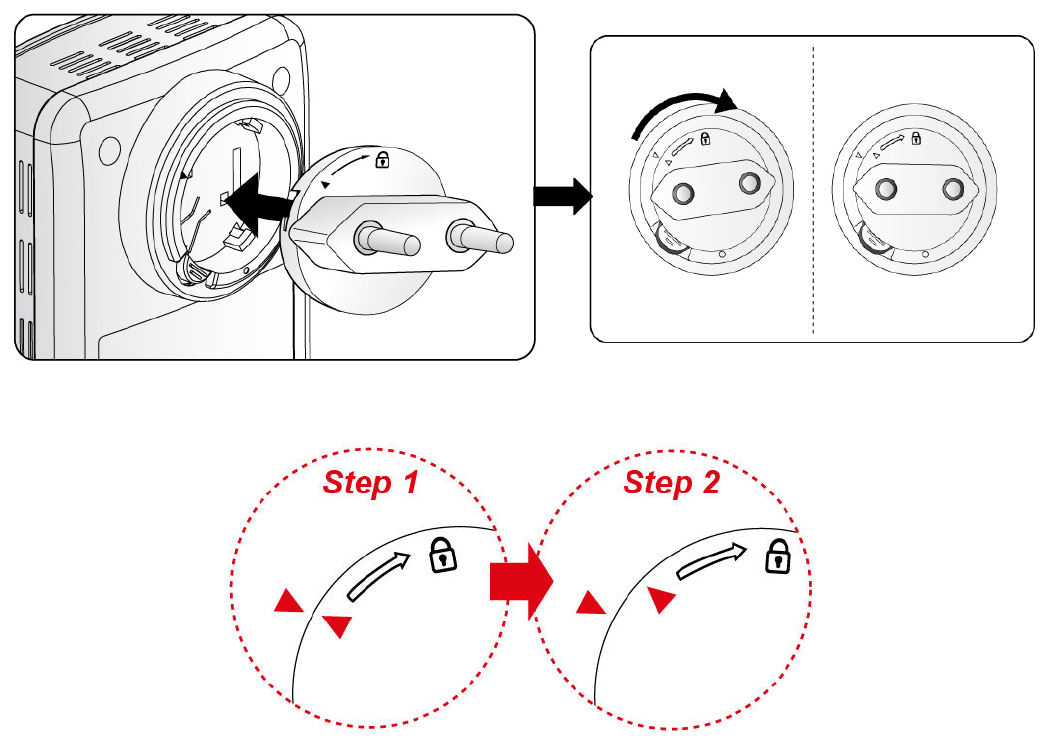
6
Hardware Installation
Refer to the following diagrams and direction to install the clip with Wireless-N HomePlug AV 200
Ethernet Adapter:
Example 1: EU clip
Please check the lock instruction on your clip.•
If you got the “Triangle Lock”, refer to right diagram.•
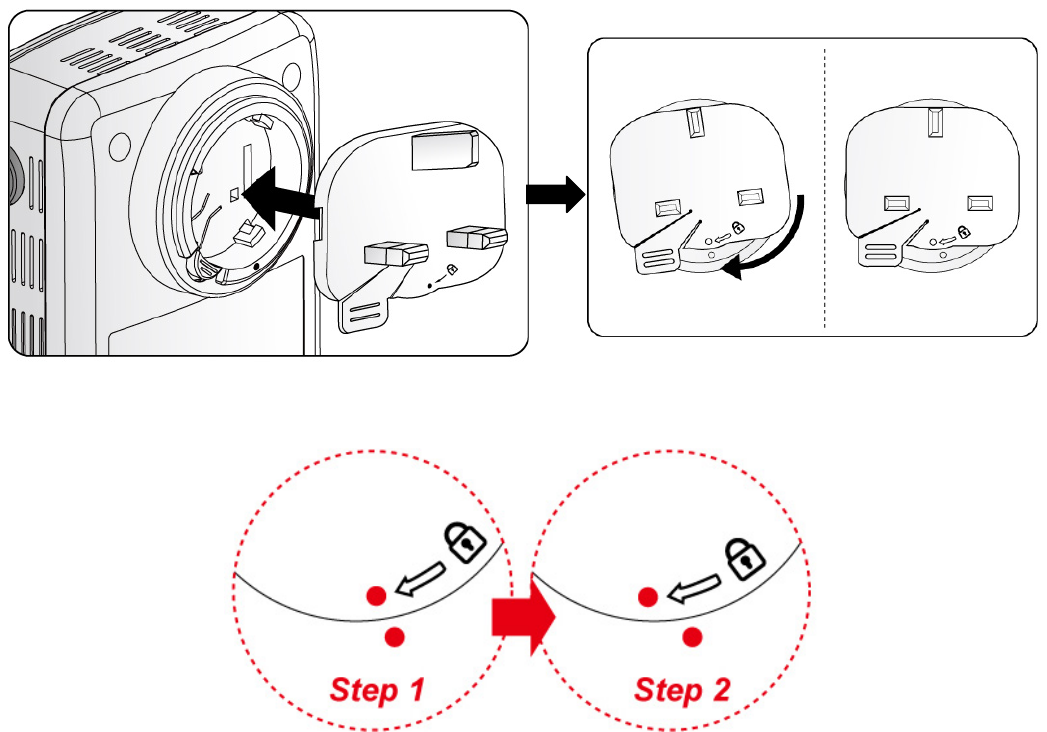
Example 2: UK clip
Please check the lock instruction on your clip.•
If you got the “Circle Lock”, refer to right diagram.•
7
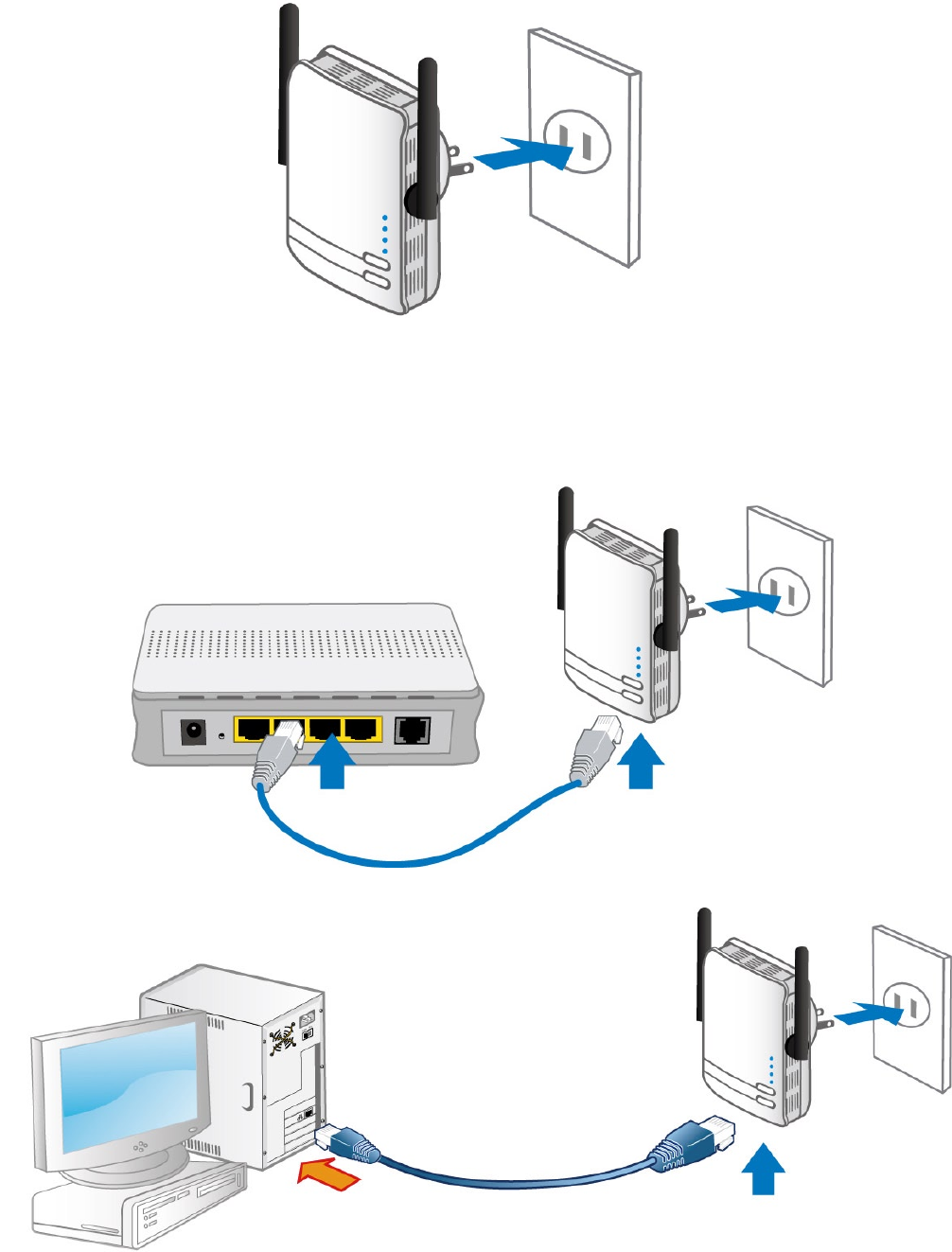
8
Connecting the HomePlug Adapter
It is easy to connect the device simply by performing the following instructions:
Power Connection
Plug the Wireless-N Homeplug AV 200 Ethernet Adapter into the wall outlet/socket.
LAN Connection
Connect the supplied RJ-45 Ethernet cable to the Ethernet port on Wireless-N HomePlug AV 200
Ethernet adapter and the other side to the device’s Ethernet interface.
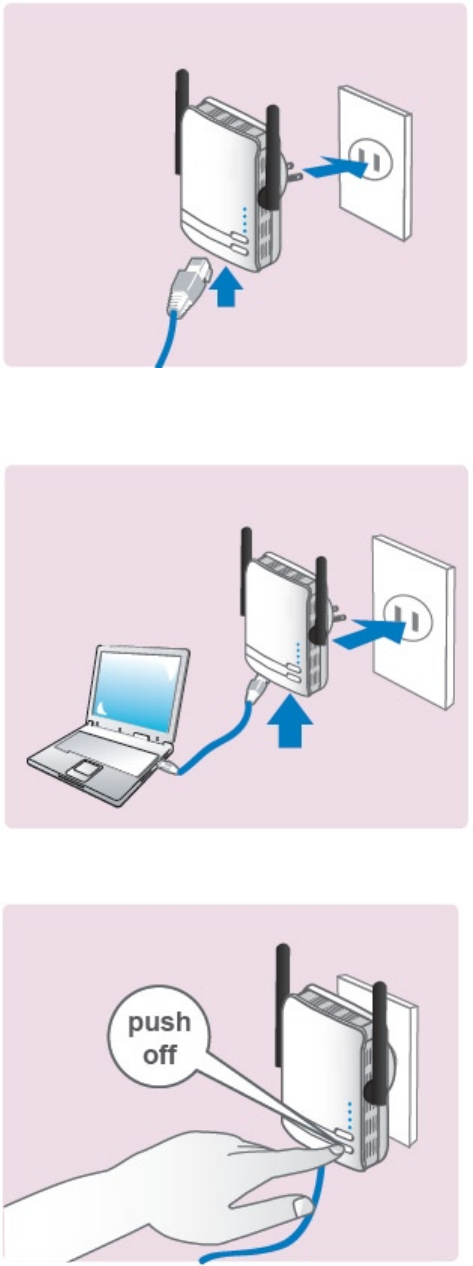
Networking Setup
Refer to the following steps:
Connect a network cable to the bridge and then plug the Wireless-N HomePlug AV 200 1.
Ethernet Adapter into a power socket.
Then connect the Wireless-N HomePlug AV 200 Ethernet Adapter to a laptop, modem, router 2.
or a set-top-box.
Create a secure network by a simply push off the network SYNC button.3.
Note: Plug/socket, power cable and input voltage/frequency may vary from country to
country.
9
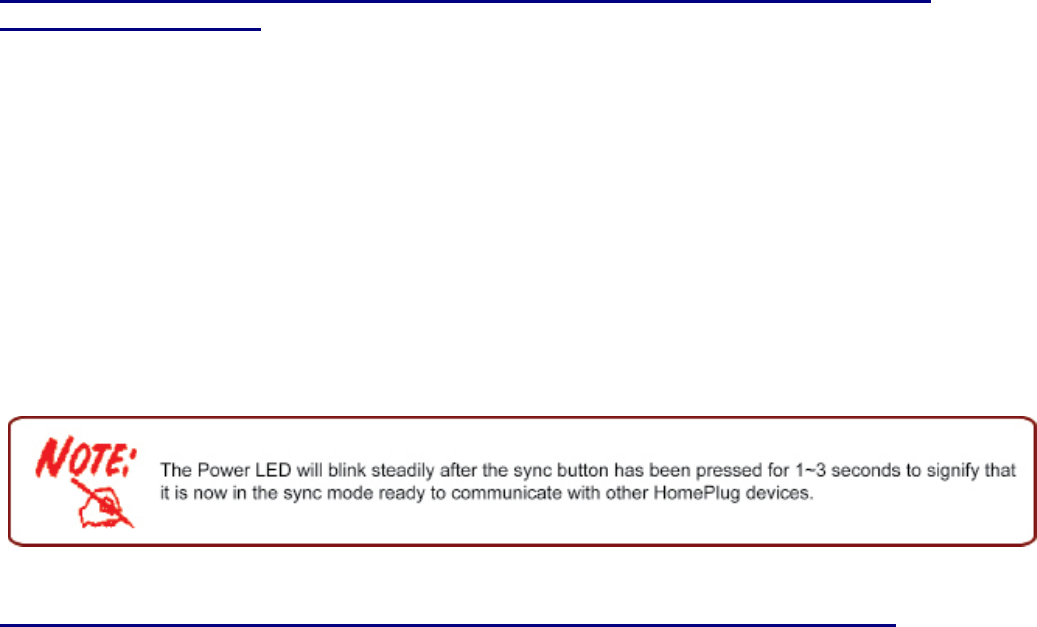
10
Quick Start (Setup Powerline Network)
Push Button usage
Sync Button is used to add a HomePlug device to a Powerline network or enable it to join a
network by pressing the Sync Button of the device to turn it into Broadcast state or Join state.
There are 3 types of Sync Button trigger states:
Broadcast State: Enable HomePlug AV device to provide information for another HomePlug 1.
AV device to join its powerline network group (works even if it is the only device existing within
the network group).
Join State: This allows an ungrouped HomePlug AV device to join an existing powerline 2.
network group.
Ungroup State: Press the Sync Button for more than 10 seconds to detach the device from 3.
its network group.
Application Scenarios
Scenario 1: A HomePlug AV device A wants to form a network group with another
HomePlug AV device B
You can assign whichever device (A or B) to be in the Broadcast State and the other in the Join
State.
Example:
Press the Sync Button of device A for 1~3 seconds to turn it into Broadcast State, you should 1.
nd the Power LED blinks steadily signifying it is in Broadcast state.
Press the Sync Button of device B for 1~3 seconds to turn it into Join State, you should nd 2.
the Power LED blinks steadily signifying it is in Join state.
Wait for both devices to boot again (all LEDs will turn off and on) and when the PLC LEDs of 3.
both devices lit steadily, you will now have these devices being in the same network group.
Scenario 2: A HomePlug AV device wants to join an existing network group BC
Device A wants to join a network group “BC” currently consisting of device B and device C. Any
devices within the “BC” group can become the “Broadcast State” and device A will be the “Join
State”.
Example:
Press the Sync Button of device A for more than 10 seconds to make sure that it is detached 1.
completely from any possible network group.
Press the Sync Button of device B or C of the BC network group for 1~3 seconds to turn it into 2.
Broadcast State, you should nd the Power LED blinks steadily signifying it is in Broadcast
state.
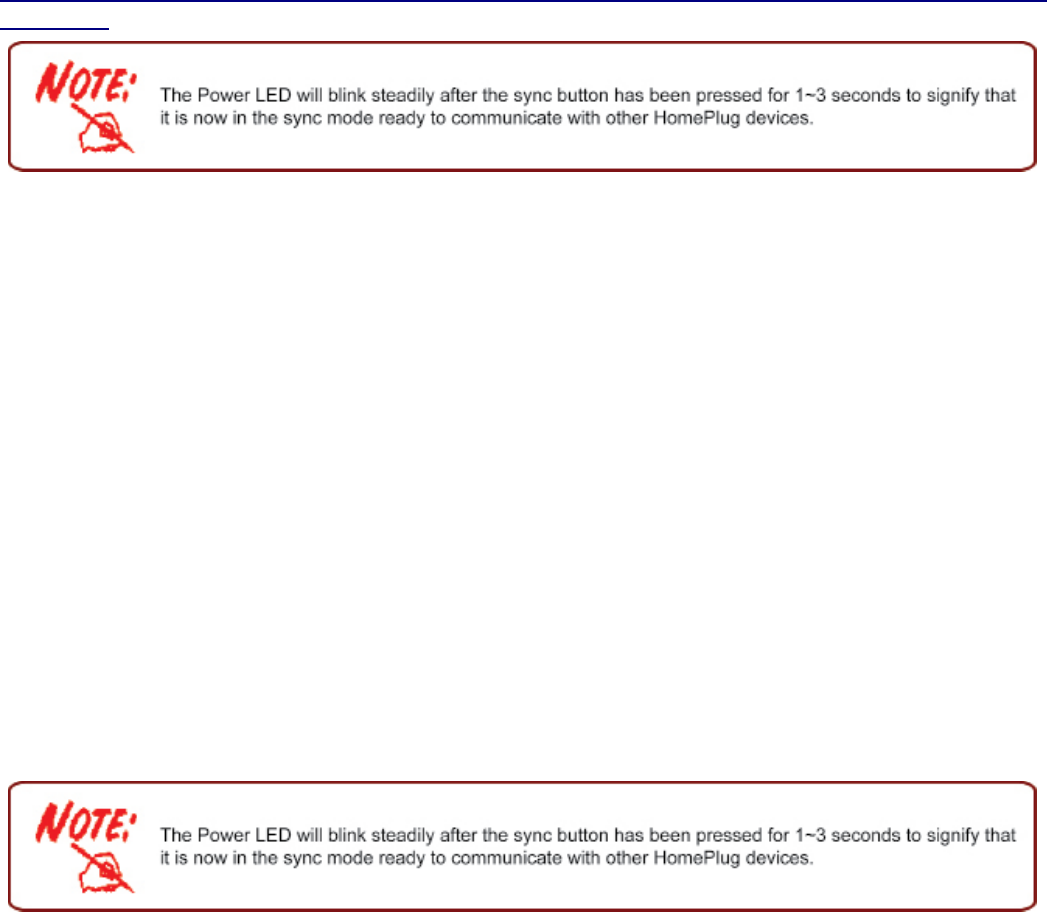
11
Press the Sync Button of device A for 1~3 seconds to turn it into Join State, you should nd 3.
the Power LED blinks steadily signifying it is in Join state.
Wait for the devices to boot again and when the PLC LEDs of both devices lit steadily, you 4.
will now have device A joined with the BC network group.
Scenario 3: A HomePlug AV device A of network group AD wants to join an existing network
group BC
For a device which already belongs to a network group is to join with a different network group,
that device has to be ungrouped from its current attached group rst.
Example:
Press the Sync Button of device A for more than 10 seconds to ungroup it from network group 1.
AD.
Then press the Sync Button of device (B or C) of network group BC for 1~3 seconds to turn it 2.
to Broadcast State, you should nd the Power LED blinks steadily signifying it is in Broadcast
state.
Press the Sync Button of device A again for 1~3 seconds to turn it to Join State, you should 3.
nd the Power LED blinks steadily signifying it is in Join state.
Wait for the Sync LED of both devices A and (B or C) lit steadily. Now you will have device A 4.
join the network group BC.
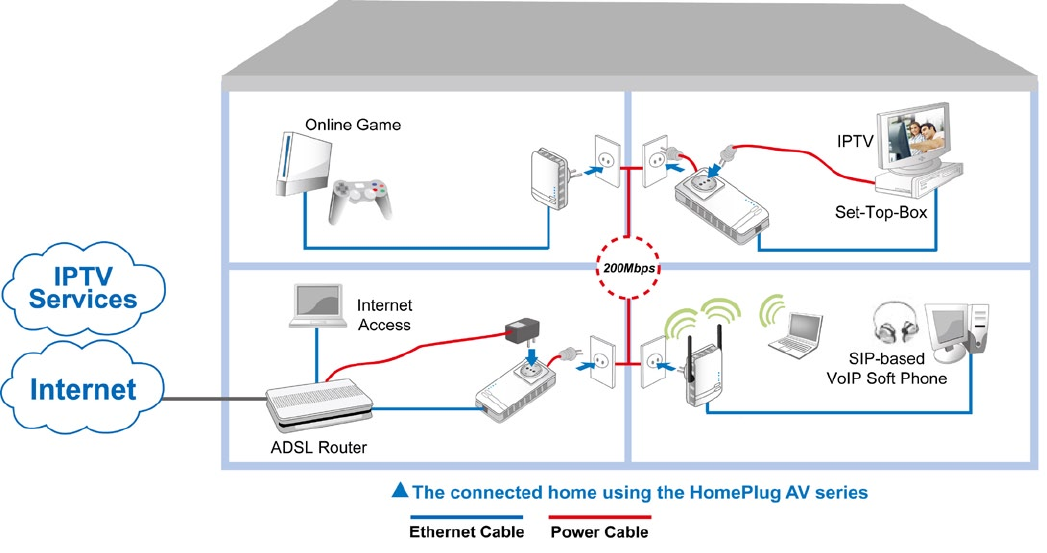
Powerline Network Illustration
12

Chapter 3: Basic Network Installation
The HomePlug adapter can be congured through your web browser. A web browser is included as
a standard application in the following operating systems: Linux, Mac OS, Windows 98/NT/2000/XP/
Me/Vista, etc. The product provides an easy and user-friendly interface for conguration.
Please check your PC network components. The TCP/IP protocol stack and Ethernet network
adapter must be installed. If not, please refer to your Windows-related or other operating system
manuals.
There are ways to connect the device, either through an external repeater hub or connect directly
to your PCs. However, make sure that your PCs have an Ethernet interface installed properly prior
to connecting the device. You ought to congure your PCs to obtain an IP address through a DHCP
server or a xed IP address that must be in the same subnet as the device. The default IP address
of the device is 192.168.1.254 and the subnet mask is 255.255.255.0 (i.e. any attached PC must
be in the same subnet, and have an IP address in the range of 192.168.1.1 to 192.168.1.253). The
best and easiest way is to congure the PC to get an IP address automatically from the device
using DHCP. If you encounter any problem accessing the HomePlug AV adapter web interface it is
advisable to uninstall your rewall program on your PCs, as they can cause problems accessing
the IP address of the device. Users should make their own decisions on what is best to protect their
network.
Please follow the following steps to congure your PC network environment.
13
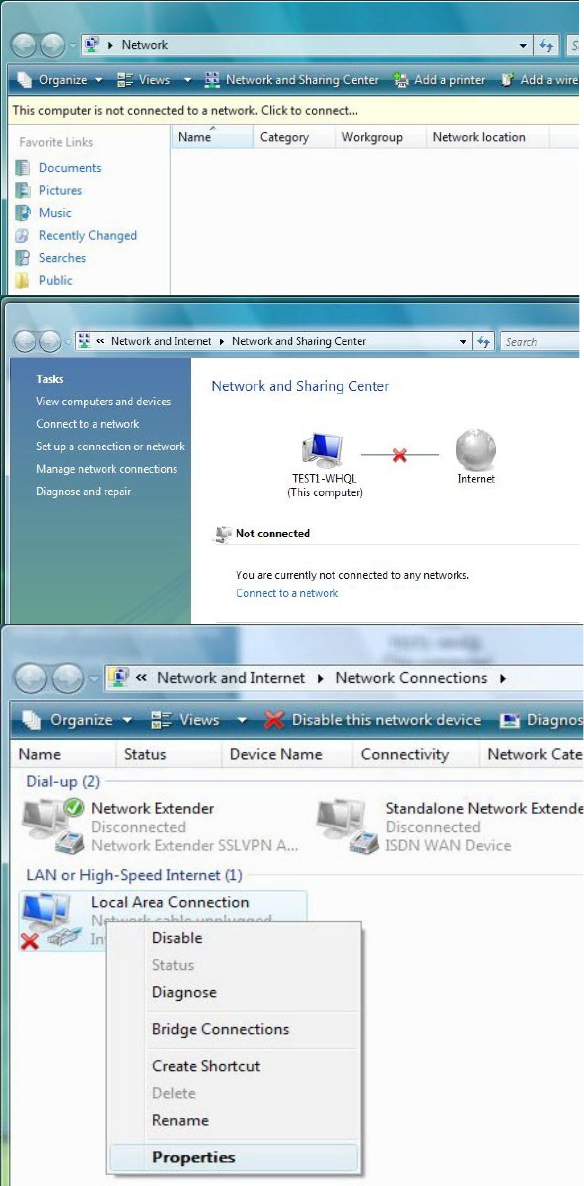
Network Conguration
Conguring PC in Windows Vista
Go to Start. Click on Network.1.
Then click on Network and 2.
Sharing Center at the top bar.
When the Network and Sharing 3.
Center window pops up, select
and click on Manage network
connections on the left window
column.
Select the Local Area Connection, 4.
and right click the icon to select
Properties.
14
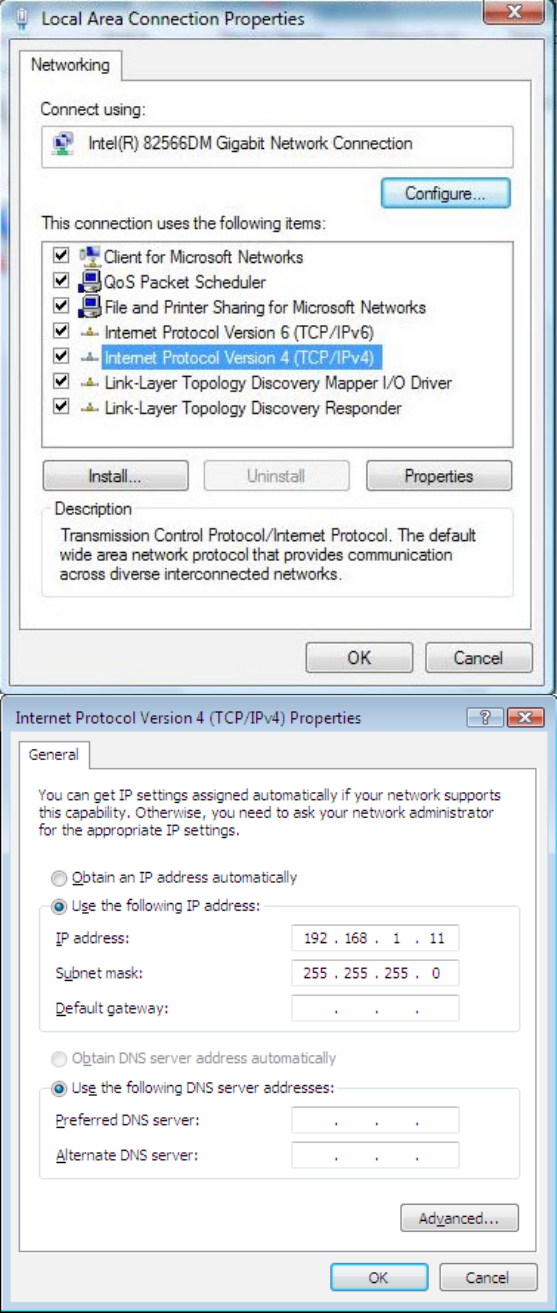
Select Internet Protocol Version 4 5.
(TCP/IPv4) then click Properties.
In the TCP/IPv4 properties window, 6.
click Use the following IP address
and Use the following DNS server
address radio buttons. Then click
OK to exit the setting.
Click OK again in the Local Area 7.
Connection Properties window to
apply the new conguration.
15
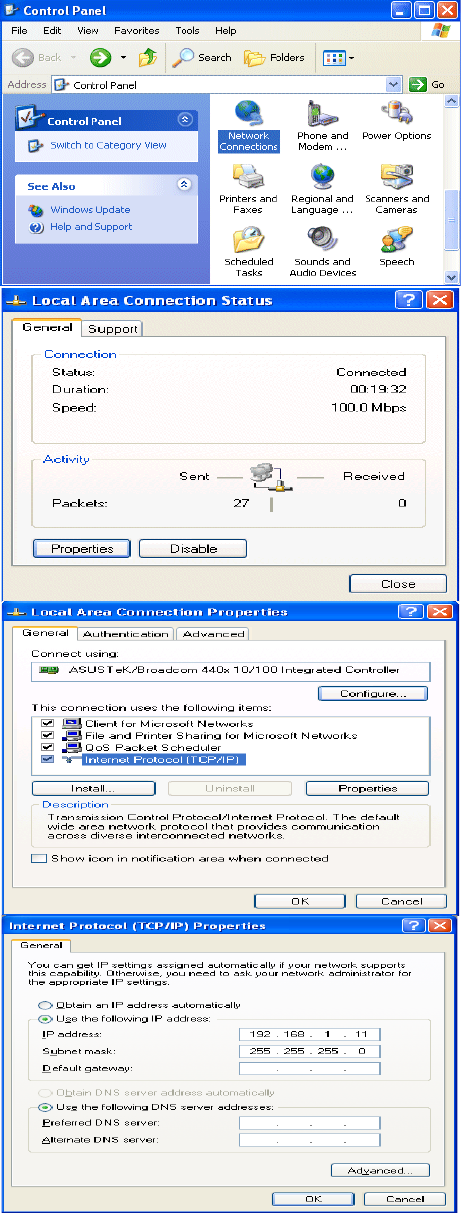
Conguring PC in Windows XP
Go to Start > Control Panel (in Classic 1.
View). In the Control Panel, double-click
on Network Connections
Double-click Local Area Connection.2.
In the Local Area Connection Status 3.
window, click Properties.
Select Internet Protocol (TCP/IP) and 4.
click Properties.
Click Use the following IP address and 5.
Use the following DNS server address
radio buttons.
Click OK to nish the conguration.6.
16
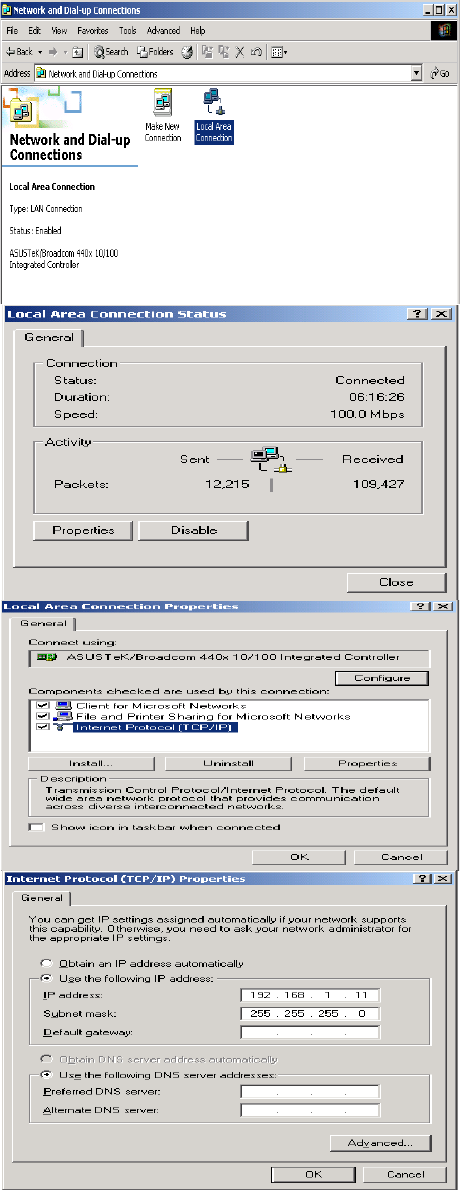
Conguring PC in Windows 2000
Go to Start > Settings > Control Panel. 1.
In the Control Panel, double-click on
Network and Dial-up Connections.
Double-click Local Area Connection.2.
In the Local Area Connection Status 3.
window click Properties.
Select Internet Protocol (TCP/IP) and 4.
click Properties.
Click Use the following IP address and 5.
Use the following DNS server address
radio buttons.
Click OK to nish the conguration.6.
17
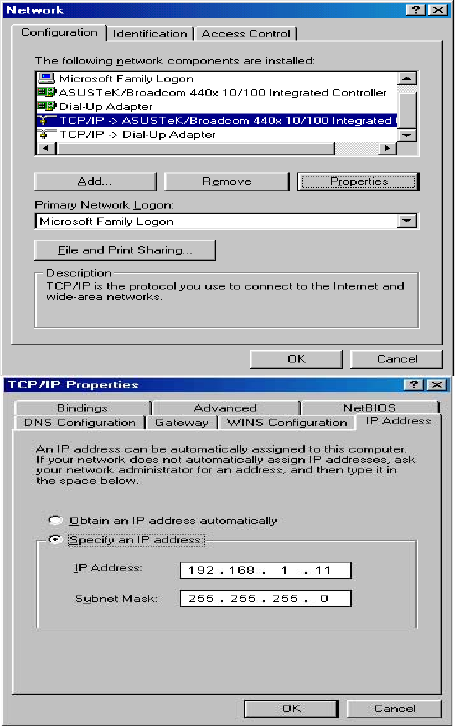
Conguring PC in Windows 95/98/Me
Go to Start > Settings > Control Panel. 1.
In the Control Panel, double-click on
Network and choose the Conguration
tab.
Select TCP/IP > NE2000 Compatible, 2.
or the name of your Network Interface
Card (NIC) in your PC.
Click Specify an IP address radio 3.
button.
Click OK to nish the conguration.4.
18
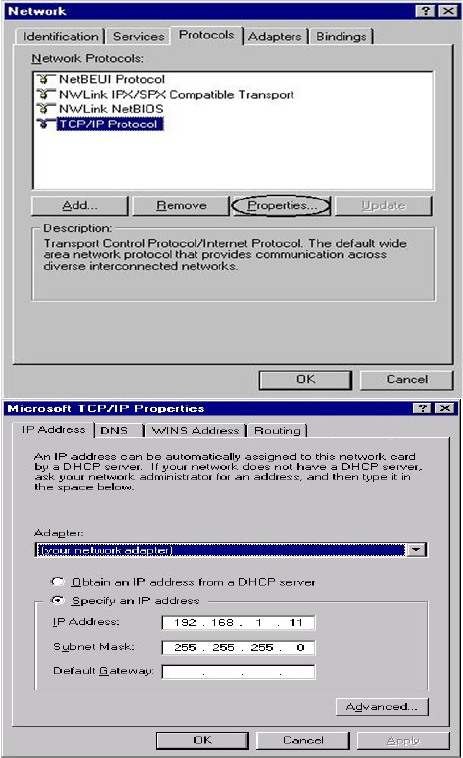
Conguring PC in Windows NT4.0
Go to Start > Settings > Control Panel. 1.
In the Control Panel, double-click on
Network and choose the Protocols tab.
Select TCP/IP Protocol and click 2.
Properties.
Click Specify an IP address radio 3.
button.
Click OK to nish the conguration.4.
19

Factory Default Settings
Before conguring your adapter, you need to know the following default settings.
Web Interface (Username and Password)
Username: admin
Password: admin
The default username and password are “admin” and “admin” respectively.
Device LAN IP settings
IP Address: 192.168.1.254
Subnet Mask: 255.255.255.0
DHCP server
DHCP server is disabled.
Start IP Address: 192.168.1.100
IP pool counts: 101
20
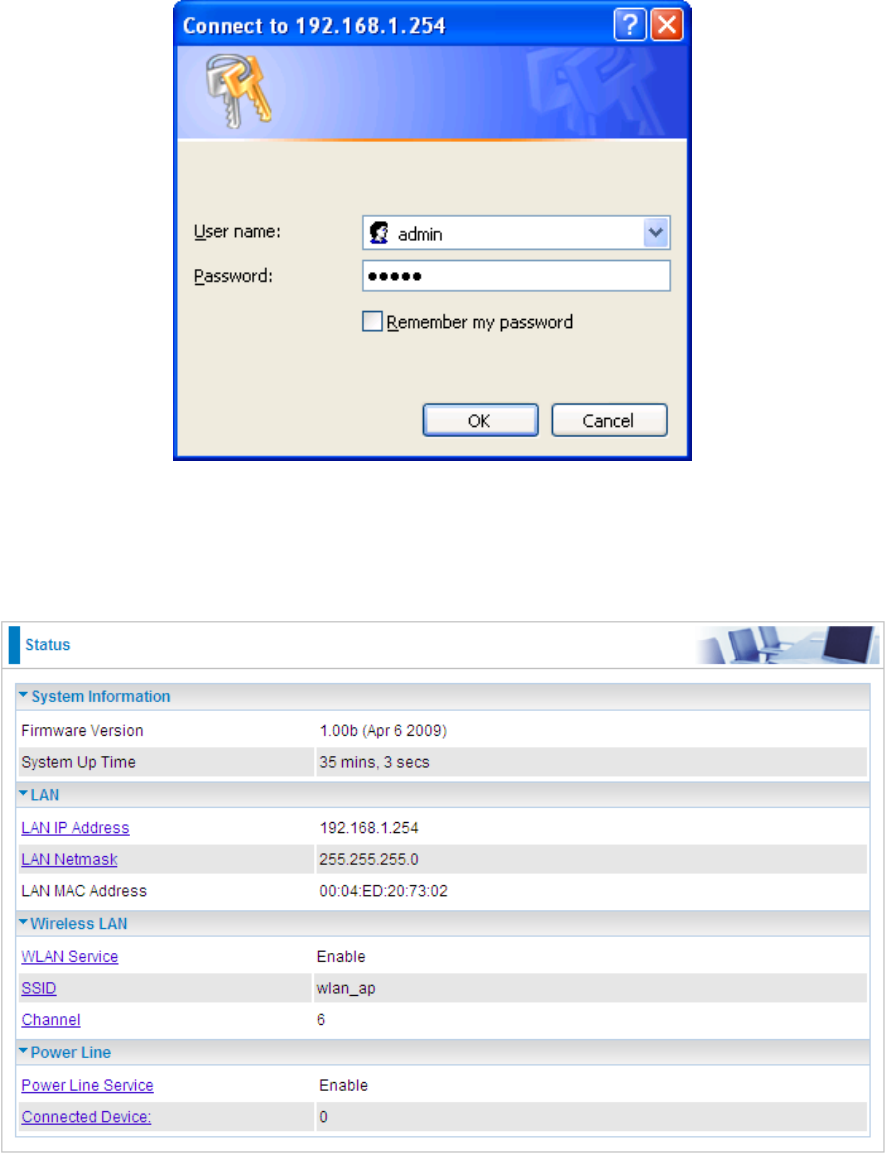
Internet Access Conguration
To congure this device for internet access, you must have IE 5.0 / Netscape 4.5 or above
installed on your computer. There is basically one way to congure your device before you are
able to connect to the internet: Web Interface. Conguration of this method will be discussed in
detail in the following section.
Conguring with your Web Browser
Open your web browser, enter the IP address of your Ethernet Adapter which by default is
192.168.1.254, and click “Go”. A user name and password window prompt will appear. The default
username and password are “admin” and “admin”.
Congratulations! You are now successfully logon to the Wireless-N HomePlug AV 200 Ethernet
Adapter!
If the authentication succeeds, the homepage will appear on the screen.
21
22
Chapter 4: Conguration
Once you have logged on to your adapter GUI via your web browser, you can begin to congure the
device according to your needs. On the conguration homepage, the left navigation pane provides
the links to different setup pages.
Status (Status / Statistic) ♣
Internet Setting (LAN) ♣
Wireless Settings (Basic / Security / Advanced / WPS / Station List) ♣
Power Line Settings (Status / Privacy / Qos) ♣
Administration (Mamagement / Upload Firmware / Settings Mamagement / System Log) ♣
Each of these setup pages will be discussed in detail in sections that follow ahead.
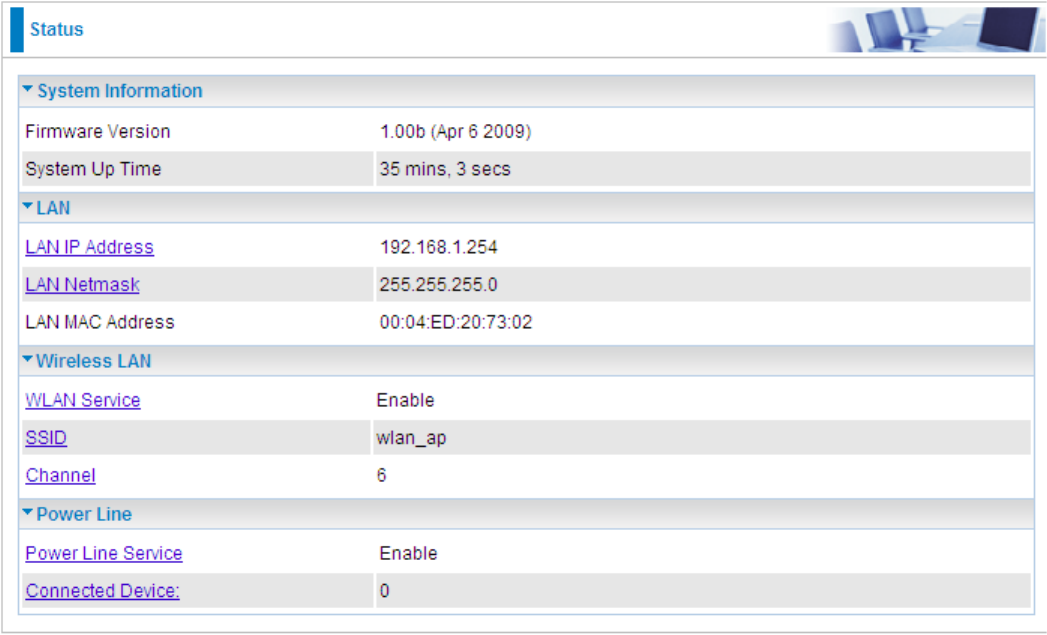
23
Status
Status
System Information
Firmware Version: Displays the rmware version for this device.
System Up Time: Records system up-time.
LAN
LAN IP Address: The current IP on this device.
LAN Netmask: The current subnet mask on this device.
Note: Click the LAN IP Address or LAN Netmask link to change the settings.
LAN MAC Address: The MAC address for the device.
Wireless LAN
WLAN Service: Status of the WLAN connection.
SSID: A unique name used to identify the wireless LAN to which a user wants to connect.
Channel: The current status in WAN interface.
Note: Click the WLAN Service, SSID or Channel link to change the settings.
Power Line
Power Line Service: State of power line.
Connected Device: Displays the number of the remote power line device(s).
Note: Click the Power Line Service or Connected Device link to display the power line
information.
24
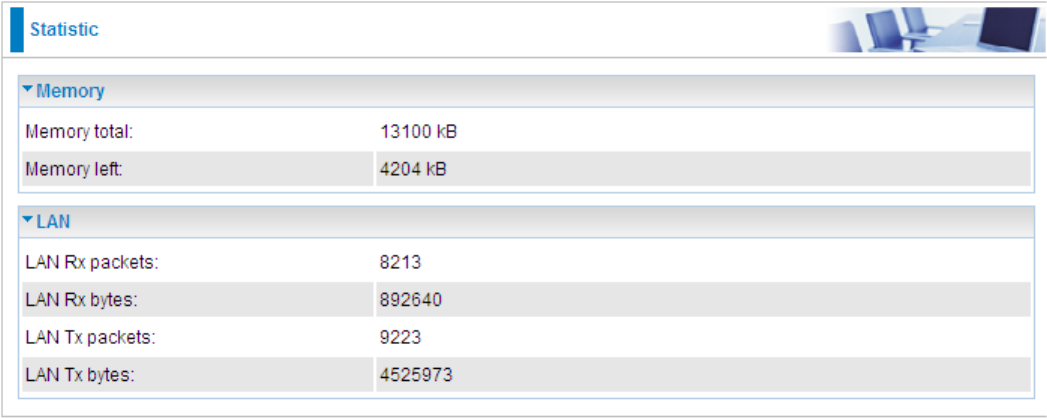
25
Statistic
Memory
Memory total: Displays the total memory size of the device (in bytes).
Memory left: Displays the amount of memory left (in bytes).
LAN
LAN Rx packets: Displays the number of received packets.
LAN Rx bytes: Displays the received packet trafc (in bytes).
LAN Tx packets: Displays the number of transferrd packets.
LAN Tx bytes: Displays the transferrd packet trafc (in bytes)
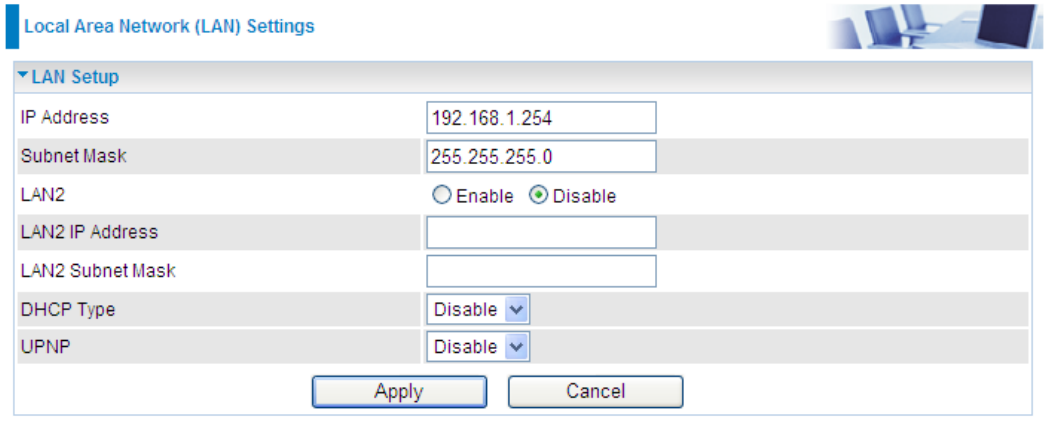
26
Internet Setting
LAN
IP Address: Enter the preferred IP address. Default is 192.168.1.254.
Subnet Mask: Enter the preferred subnet mask. Default is 255.255.255.0.
LAN2: This function enables the creation of multiple virtual IP interfaces for this device. It helps
to connect two or more local networks to the ISP or remote node. In this case, an internal device
is not required. Default setting is Disable. If you want to active IP Alias function, please select
Enable.
LAN2 IP Address: Specify an IP address for this virtual interface.
LAN2 Subnet Mask: Specify a subnet mask for this virtual interface.
DHCP Type: You can disable or enable the function with DHCP server. The default type is
Disable. The conguration of each item is described in DHCP Server section.
UPNP: UPnP offers peer-to-peer network connectivity for PCs and other network devices, along
with the feature to control data transfer between devices. Default is Disable.
Enable: ♣ Select to inactive the device’s UPnP functionality.
Disable: ♣Select to active the device’s UPnP functionality.
Click Apply to save the changes or Cancel to recover the default setting.
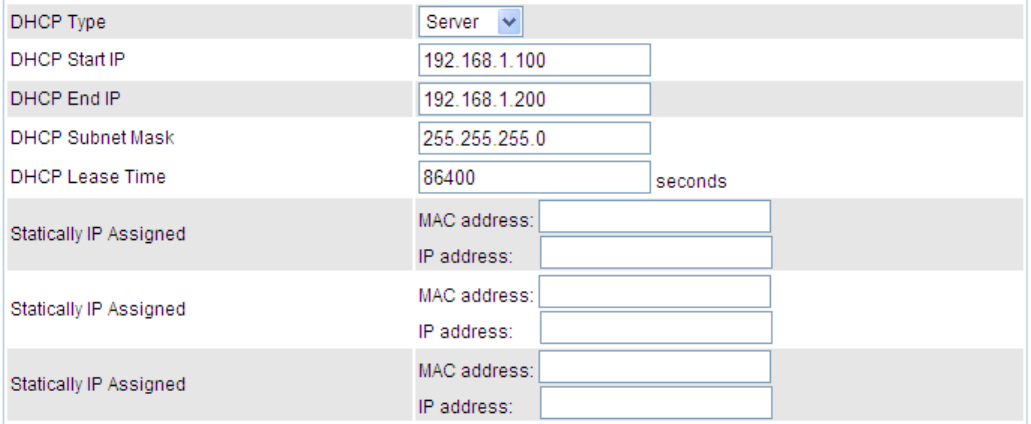
27
DHCP Server
DHCP allows networked devices to obtain information on the parameter of IP, Netmask, and so
forth through the Ethernet Address of the device.
DHCP Type: To congure the device’s DHCP Server, select Server from the DHCP Type drop-
down menu and you can then congure parameters of the DHCP Server.
DHCP Start IP/ End IP: Enter the starting and ending IP address of the range of IP addresses
that you want the DHCP server to assign to DHCP clients. The default DHCP IP range is
192.168.1.100 to 192.168.1.200.
DHCP Subnet Mask: Enter the subnet mask for the network address that you specied. The
default is 255.255.255.0.
DHCP Lease Time: Enter the time value (in seconds) that you want the assigned IP address to be
valid for. The DHCP client must obtain a new IP address from the DHCP server when this value
expires.
Statically IP Assigned: You can map the MAC address for stations that you want to always be
assigned the same IP address. Mapped IP addresses must be outside the DHCP start/end IP
range. You can congure up to 3 sets of MAC and IP addresses in this table.
28
Wireless Settings
When you click this item, the column will expand to display the sub-items that will allow you to
congure your wireless settings.
Basic, Security, Advanced, WPS and Station List
The function of each conguration sub-item is described in the following sections.
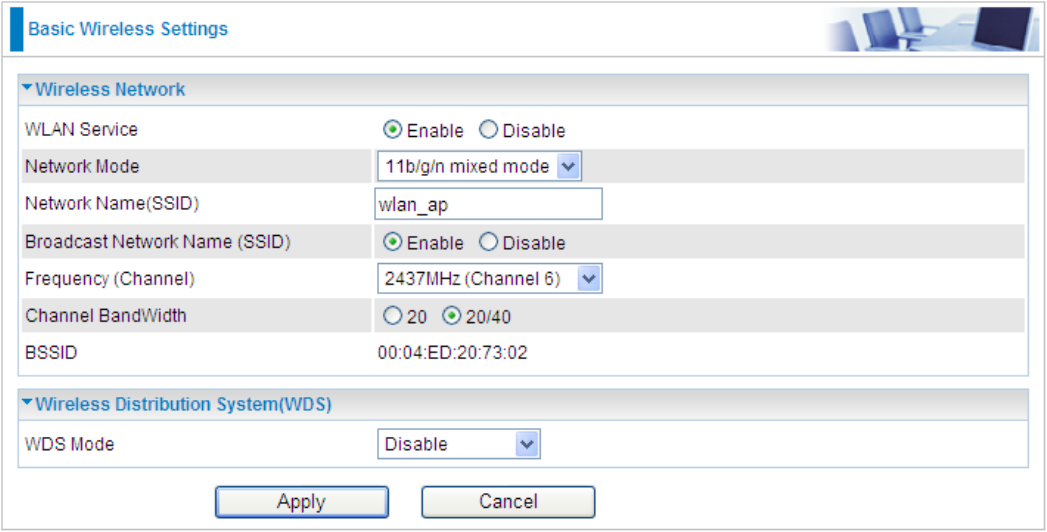
29
Basic Wireless Settings
Wireless Network
WLAN Service: Default setting is Enable. If you do not have any wireless, select Disable.
Network Mode: The default setting is 11b/g/n mixed mode. If you do not know or have both 11b,
11g and 11b devices in your network, please left this mode selected. If you have only 11b card,
please select 11b only from the drop-down menu. If you have only 11g card, please select 11g only
from the drop-down menu. If you have both 11b and 11g card, please select 11b/g mixed mode.
Network Name (SSID): The SSID is the unique name of a wireless access point (AP) used to
distinguish one from another. For security purpose, you should change the default SSID to a
unique ID name that is difcult to guess. Make sure your wireless clients have exactly the SSID as
the device in order to connect to your network.
Note: It is case sensitive and can be up to 32 characters.
Broadcast Network Name (SSID): It is used to broadcast its SSID on the network so that when
a wireless client searches for a network, the device can be discovered and recognized. Default
setting is Disable.
Enable: ♣ When enabled, you hide the SSID and the AP does not broadcast the SSID. In other
words, no one will be able to locate the access point (AP) of your device.
Disable: ♣When disabled, anybody with a wireless client is allowed to be able to locate the access
point (AP) of your device.
Frequency Channel: Select the wireless connection ID channel that you would like to use.
Note: Wireless performance may degrade if the selected ID channel is already being
occupied by other AP(s).
Channel Bandwidth: Select either 20 MHz or 20/40 MHz for the channel bandwidth. The higher
the bandwidth the better the performance will be.
BSSID: Displays the MAC address of the device.
Rate: Available when 11b/g mixed mode, 11b only and 11g are selected in Network Mode. Select
the data transmission rate from the drop-down menu. Default is Auto.
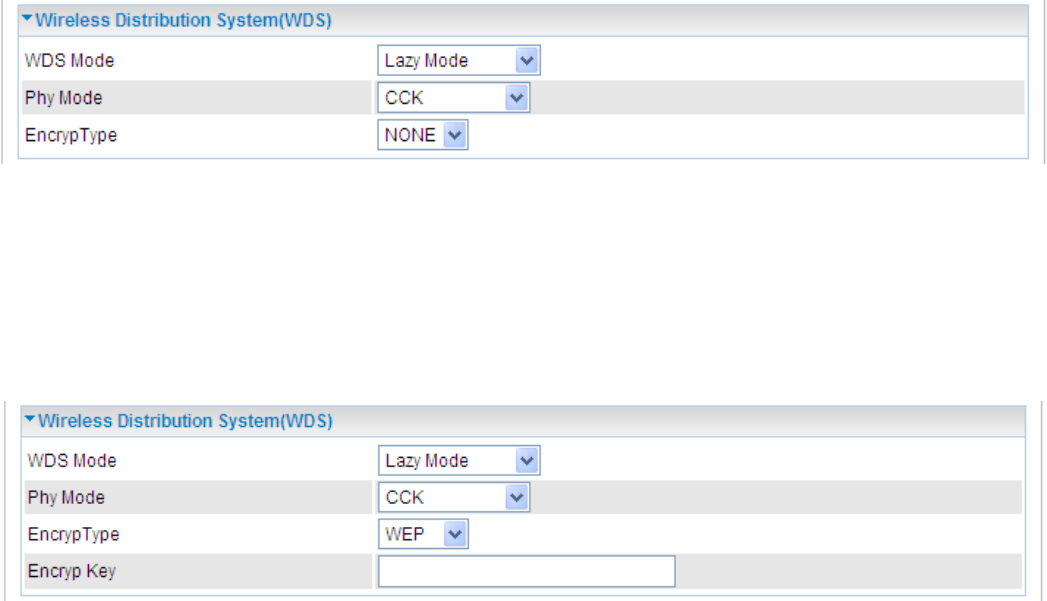
30
Wireless Distribution System (WDS)
It is a wireless access point mode that enables wireless link and communication with other access
points. It is easy to install simply by dening the peer’s MAC address of the connected AP. WDS
takes advantage of the cost saving and flexibility which no extra wireless client device is required to
bridge between two access points and extending an existing wired or wireless infrastructure network
to create a larger network.
WDS Mode: You can disable or enable the WDS functionality. Default setting is Disable.
Lazy Mode
WDS Mode: Select Lazy Mode from the drop-down menu. In this case, WDS peers can be auto-
detected.
Phy Mode: Select the appropriate mode from the drop-down menu. There are 4 options: CCK,
OFDM, HTMIX and GREENFIELD.
Encryp Type: You can select None or other types: WEP, TKIP or AES. When WEP, TKIP or AES
is seleted, the Encryp Key eld will display to allow you to set an encryption key.
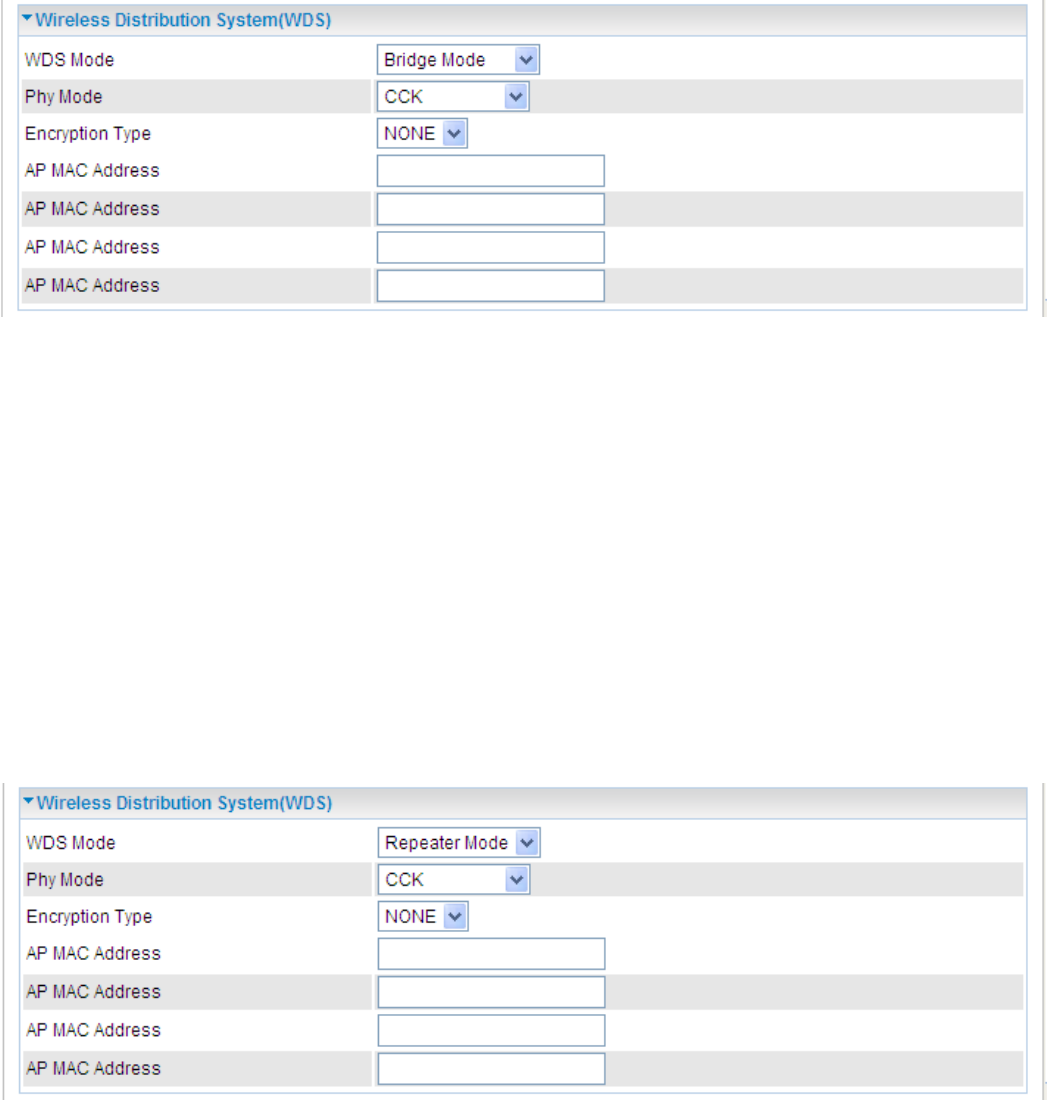
31
Bridge Mode
WDS Mode: Select Bridge Mode from the drop-down menu. In this case, AP adapter acts as a
wireless bridge and will not respond to wireless requests.
Phy Mode: Select the appropriate mode from the drop-down menu. There are 4 options: CCK,
OFDM, HTMIX and GREENFIELD.
Encryp Type: You can select None or other types: WEP, TKIP or AES. When WEP, TKIP or AES
is seleted, the Encryp Key eld will display to allow you to set an encryption key.
AP MAC Address: Enter the associated AP’s MAC Address(es) in this feild and the following
elds. It is important that your peer’s AP must include your MAC address in order to acknowledge
and communicate with each other.
Repeater Mode
WDS Mode: Select Repeater Mode from the drop-down menu. In this case, AP adapter acts as a
repeater and interconnects between access points.
Phy Mode: Select the appropriate mode from the drop-down menu. There are 4 options: CCK,
OFDM, HTMIX and GREENFIELD.
Encryp Type: You can select None or other types: WEP, TKIP or AES. When WEP, TKIP or AES
is seleted, the Encryp Key eld will display to allow you to set an encryption key.
AP MAC Address: Enter the associated AP’s MAC Address(es) in this feild and the following
elds. It is important that your peer’s AP must include your MAC address in order to acknowledge
and communicate with each other.
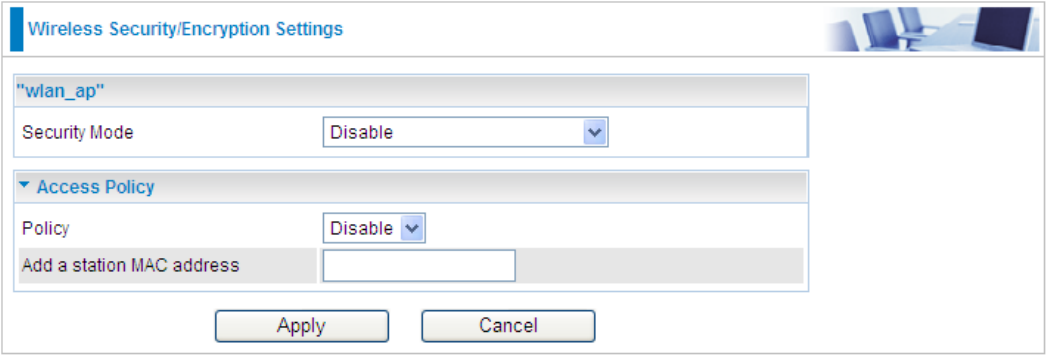
32
Wireless Security/Encryption Settings
Security Mode: You can disable or enable the wireless security function using WEP or WPA for
wireless network protection. The default mode of wireless security is disabled. Please refer to the
Security Mode section for detail description.
Access Policy
Policy: Select from the drop-down menu to choose whether the entered MAC Address should be
allowed to pass (Allow) or to be blocked (Reject).
Note: When the Policy is selected Allow, all the MAC addresses you entered in the Add
a station MAC address eld will be pass; when the Policy is selected Reject, all the MAC
addresses you entered in the Add a station MAC address eld will be blocked.
Add a station MAC address: Enter the MAC address of the wireless client.
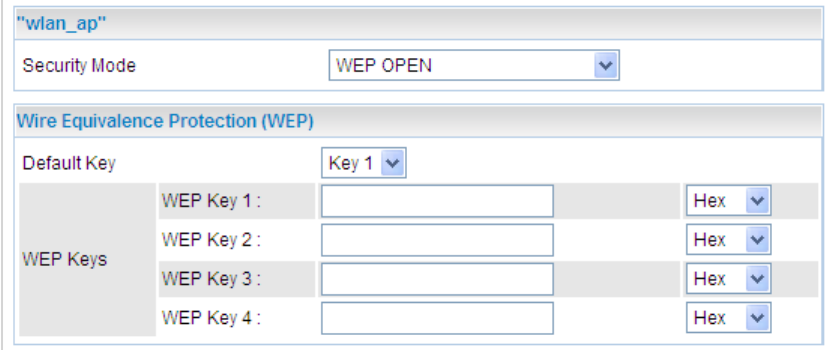
Secuirty Mode
WEP OPEN / WEP SHARED / WEP AUTO
Security Mode: Select WEP OPEN, WEP SHARED or WEP AUTO from the drop-down menu.
Wire Equivalence Protection (WEP)
Default Key: Select the encryption key ID.
WEP Keys (1~4): Enter the key to encrypt wireless data. To allow encrypted data transmission,
the WEP Encryption Key values on all wireless stations must be the same as the device. There
are four keys for your selection. The input format is in Hex or ASCII style, 5 and 13 ASCII codes
are required for WEP64 and WEP128 or 10 and 26 Hex codes are required for WEP64 and
WEP128 respectively.
33

34
WPA-PSK / WPA2-PSK / WPAPSK/WPA2PSK mix mode
Security Mode: Select WPA-PSK or WPA2-PSK from the drop-down menu.
WPA
WPA Algorithms: There are 3 types of the TKIP, AES & TKIPAES (not available in WPA-PSK
mode).
Pass Phrase: Enter a pass phrase to access the network. It can be a password like “12345678” or
a pass phrase, from 8 to 63 case-sensitive characters.
Key Renewal Interval: The period of renewal time (in seconds) for changing the security key
automatically between wireless client and Access Point (AP). Default value is 3600 seconds.
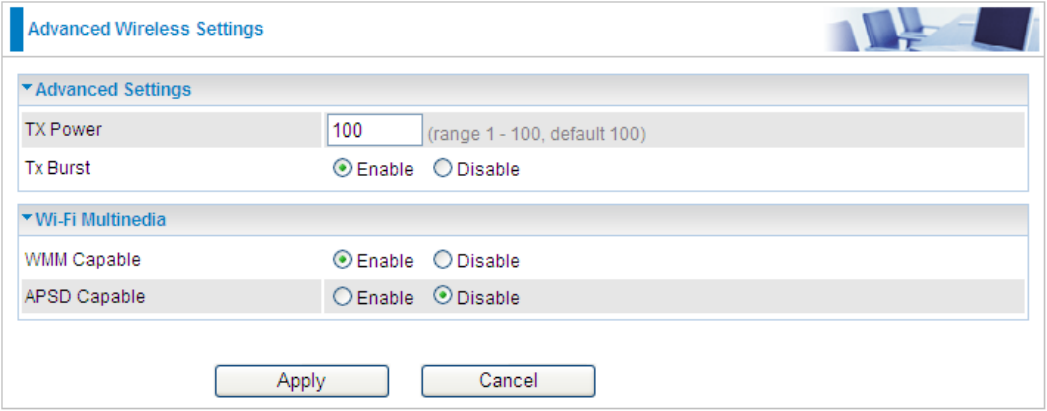
Advanced Wireless Settings
Advanced Settings
TX Power: TX Power measurement that enhances the wireless transmission signal strength. You
can adjust this power level from minimum (0) to maximum (100). Default is 100.
Tx Burst: This feature is used to active the transmitted time slot to increase transmission
throughput. Default is Enable.
Wi-Fi Multinedia
WMM Capable: This feature is used to control the prioritization of trafc according to 4 Access
categories: Voice, Video, Best Effort and Background. Default is Enable.
APSD Capable: Automatic Power Save Delivery (APSD) is an efcient power management
mechanism and is very useful for a VoIP phone. You can select enable or disable this feature.
Default is Disable.
35
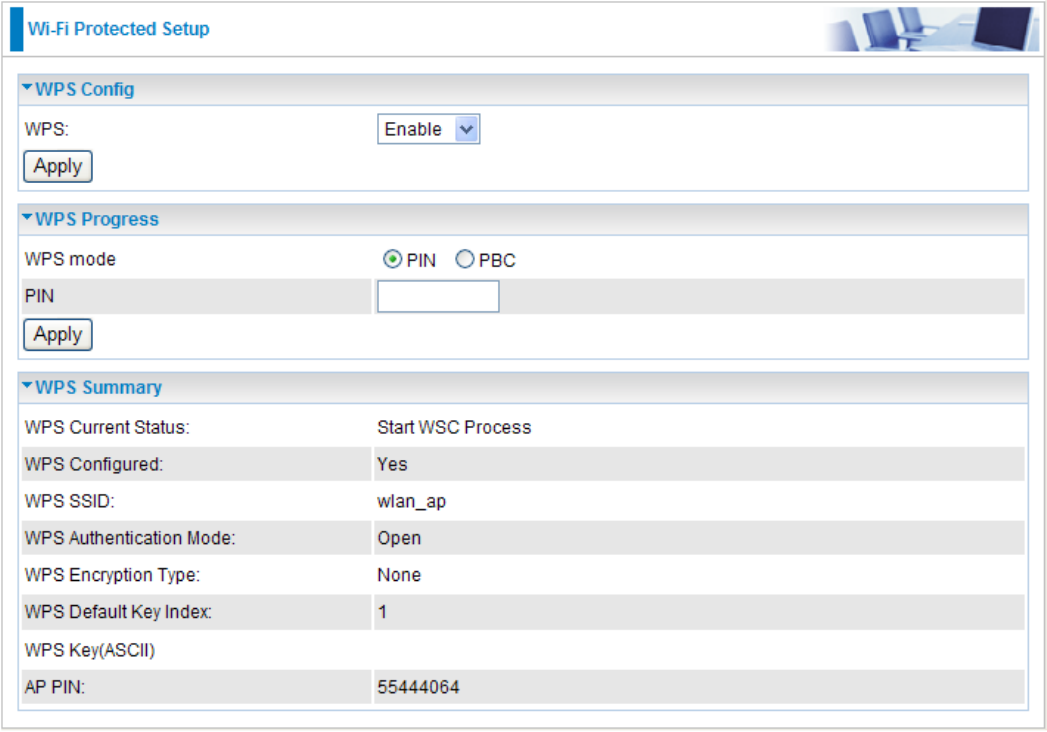
36
Wi-Fi Protected Setup
WPS feature is designed to ease setup of security enabled WiFi networks in small ofces or home.
It supports methods to you to set a network and enable security by entering a PIN or pushing a
button.
Cong
WPS: Default setting is set to Enable. If you do not want to active this functionality, please select
Disable.
WPS Progress
WPS mode: Dene the WPS mode by PIN code or PBC.
PIN ♣: Select PIN (Personal Identication Number) mode process to connect to the device.
PBC ♣: Select PBC (Push Button Communication) mode process to connect to the device.
Note: You can enable WPS PBC mode through WPS conguration interface as above or
by pushing the WPS button of your HomePlug AV 200 Ethernet Adapter for more than 1
seconds and the WPS will establish the connection automatically.
PIN: When PIN mode is selected, this eld is displayed to allow you to enter the PIN code which
the device uses to authenticate other WPS-enabled wireless devices.
WPS Summary
WPS Current Status: Displays the WPS status.
WPS Congured: Displays the current WPS conguration status
WPS SSID: Displays the WPS network name.
WPS Authentication Mode: Displays the authentication mode for WPS.
WPS Encryption Type: Displays the encryption type for WPS.
WPS Default Key Index: Displays the Default Key Index.
WPS Key(ASCII): Displays the WPS key (ASCII characters).
AP PIN: Displays the Access Point's PIN number.
37

38
Station List
The Station List displays the Wireless Network information.
Wireless Network
MAC Address: The Media Access Control (MAC) addresses for each device on your WLAN.
Aid: The association ID.
PSM: The power save mode.
MimoPS: The MIMO power save mode. MIMO, Multiple-input and multiple-output, is the use of
multiple antennas at both the transmitter and receiver to improve communication performance.
MCS: The Modulation and Coding Scheme.
BW: The Network Bandwidth.
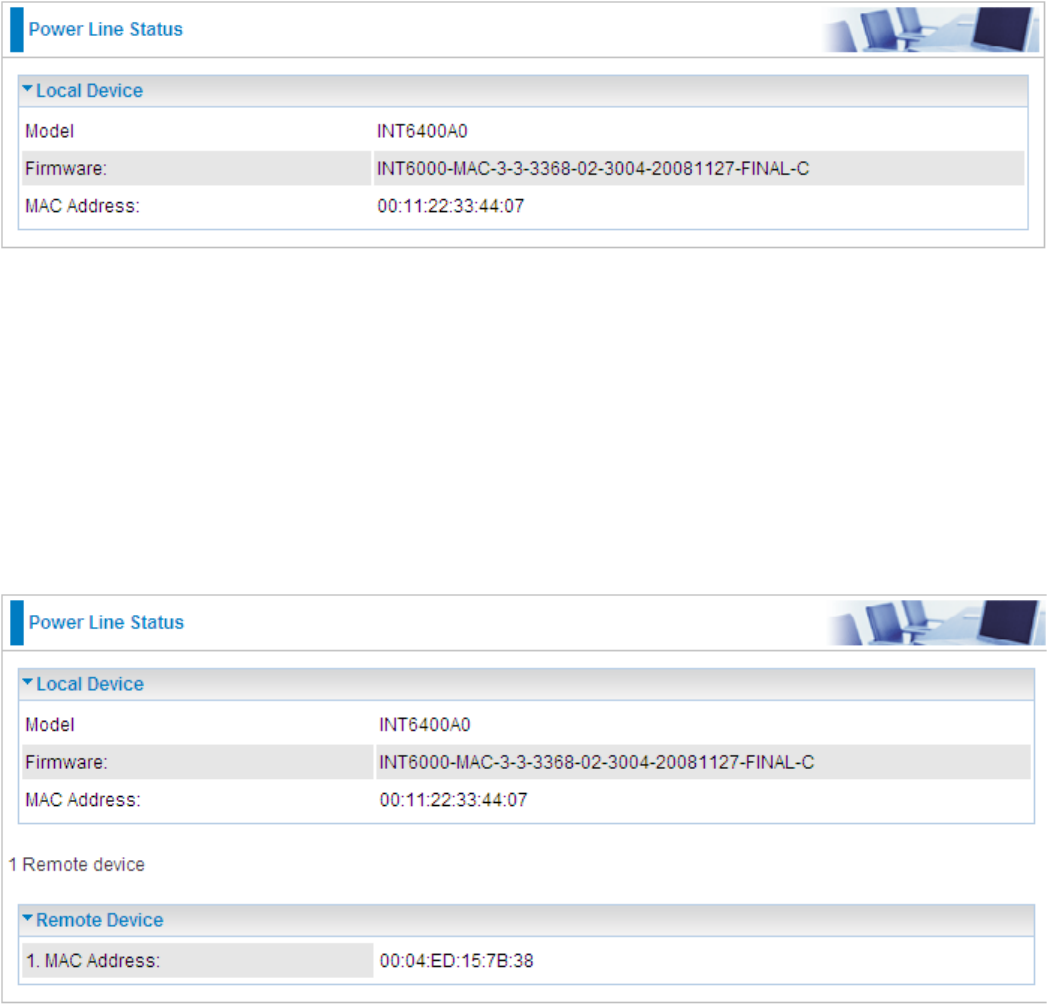
39
Power Line Settings
Status
Local Device
Model: Displays the model name for the local power line device.
Firmware: Displays the version number of rmware on the local power line device.
MAC Address: Displays the MAC address of the local power line device.
When you have successfully synchronized two HomePlug AV adapters through the powerline, the
information of both adapters will display on the Power Line Status screen.
In the illustration above, there are 1 local device and 1 remote device in the same power loop.
Remote Device
MAC Address: Displays the MAC address for the remote device.

40
Privacy
Privacy Settings
New Network Name: Enter the new network name (password) to apply to the local HomePlug
adapter. This allows the HomePlug adapters that have the same network name in the powerline
network to communicate with each other.
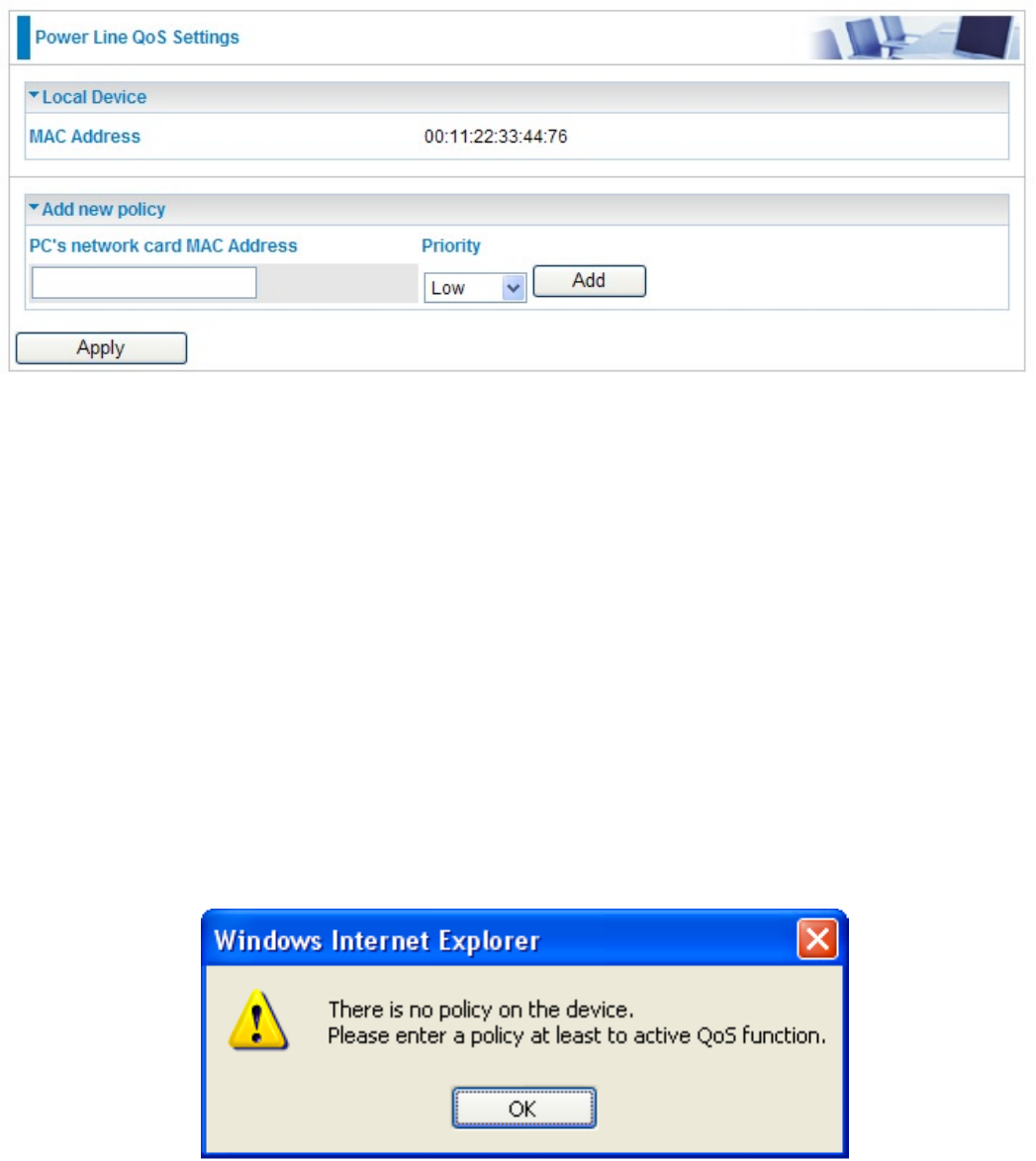
41
QoS
Wired networks use QoS to help trafc ow more smoothly. On this screen, you can prioritize
trafc passing through your adapter besed on the device it is intended for by setting MAC address
and the level of priority.
Local Device
MAC Address: Displays the MAC address.
Add new policy
Network card MAC Address: Enter the network card MAC address.
Priority: Select a priority from the drop-down menu.
Add: Press this button to add a new MAC address.
Click Apply to conrm the settings.
Note: If you set no QoS policy, the QoS setting will be returned to the factory default
settings when you click on Apply button.
Note: When there is no QoS policy on the device, a warming message will pop-up as below
after clicking Apply.
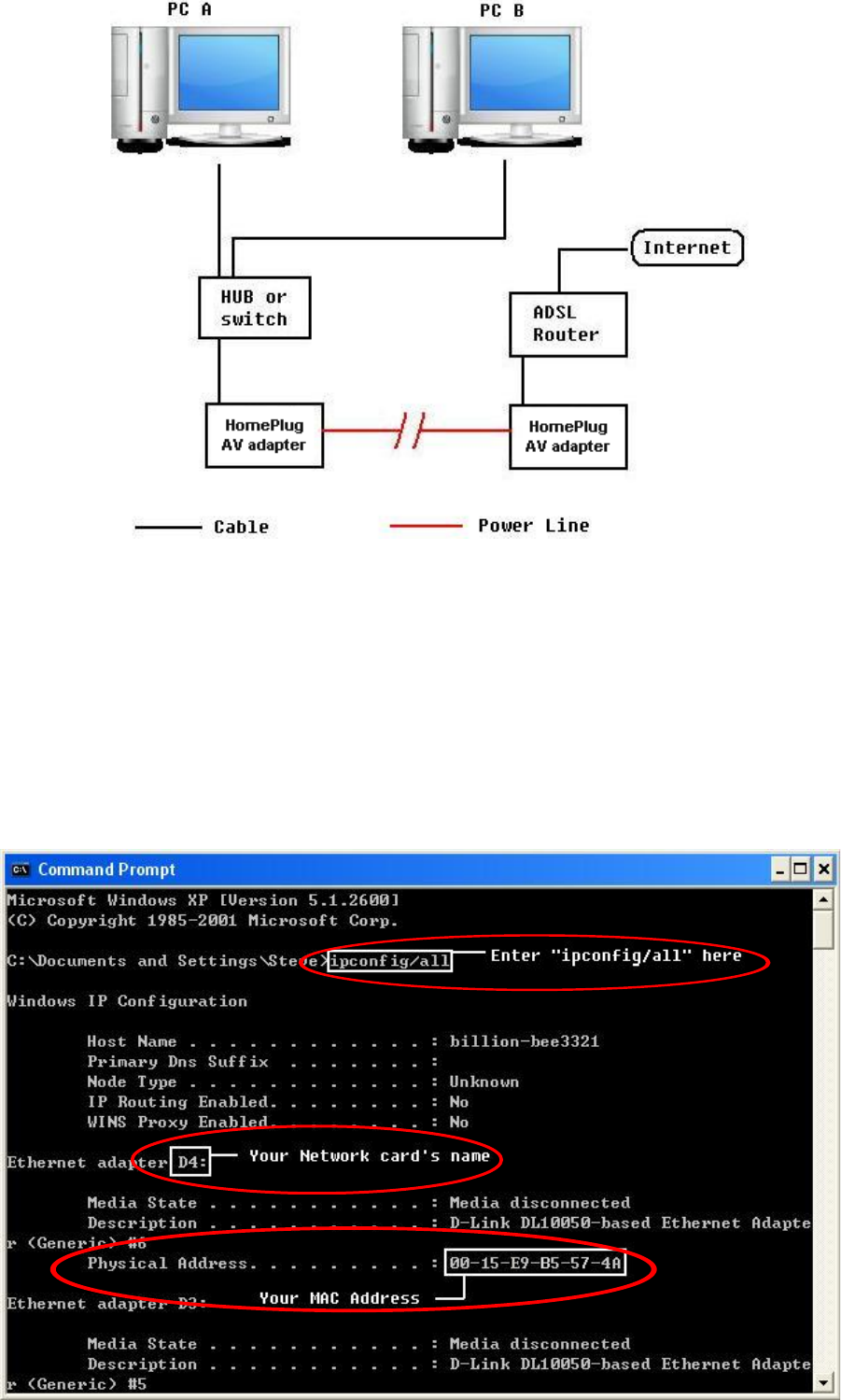
42
QoS example:
The above illustration is an example for QoS topology, commonly in the home and small ofce
environment.
To set the QoS policy, perform the following steps:
Select Power Line Settings > QoS. In the Power Line QoS Settings screen, add new policy for 1.
QoS.
Run the “Command Prompt” (From the Windows desktop click Start > Run, type 2. cmd and click
OK.). At the command prompt, type ipcong /all and press Enter. Look for the line Physical
Address.
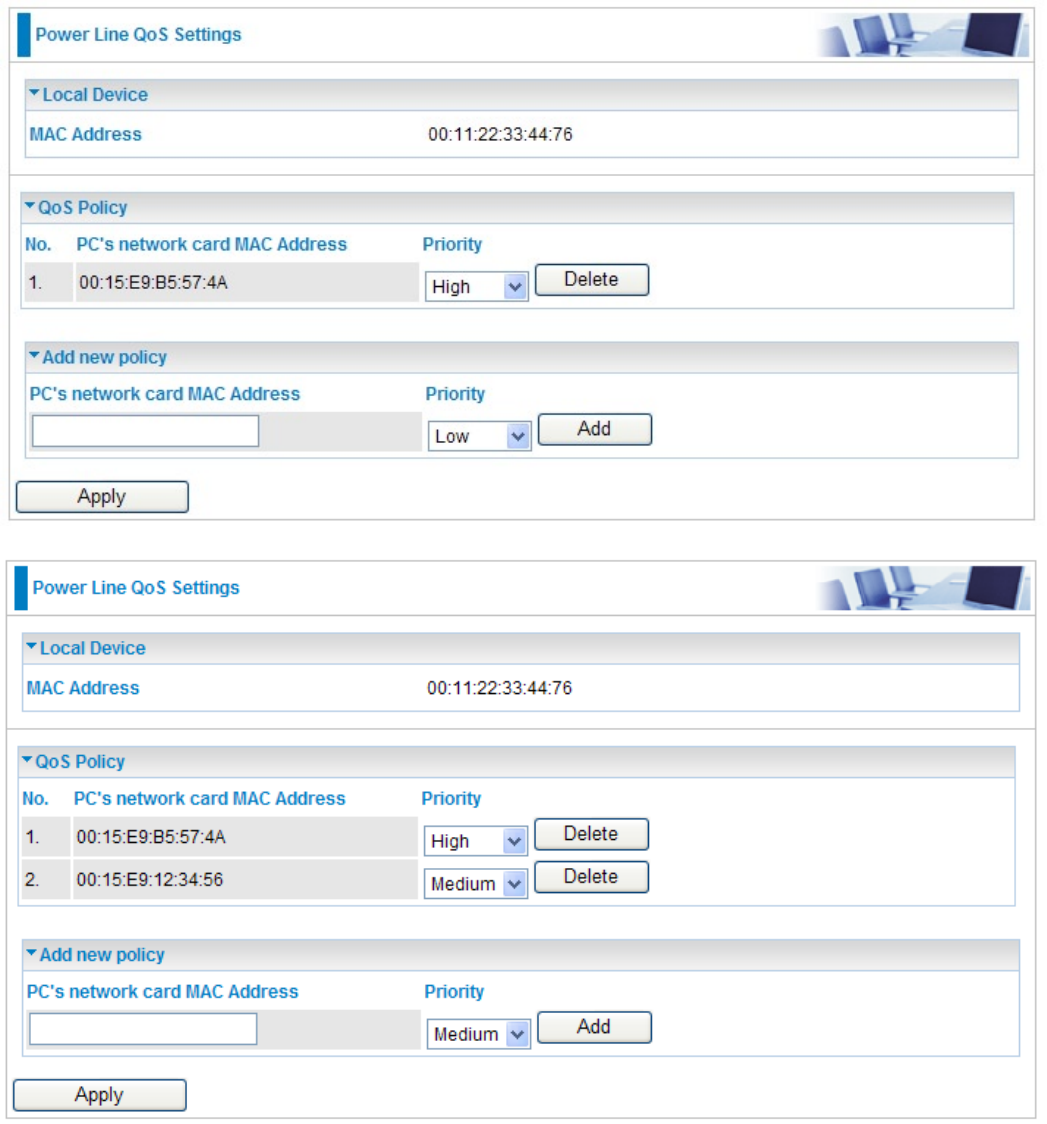
43
Go back to Power Line QoS Settings screen, enter you network card MAC address and choose 3.
the priority. Click Add button to add this new rule. You will see the new address(s) displayed in
the QoS Policy table.
Note: Make sure that the MAC Address that you entered is correct. (A MAC address uses 6
pairs of hexadecimal characters, for example 00:04:ED:01:23:45.)
You can change the priority of the QoS rule(s) from the Priority drop-down menu or remove the 4.
rule(s) by clicking on Delete button next to the item you want to delete.
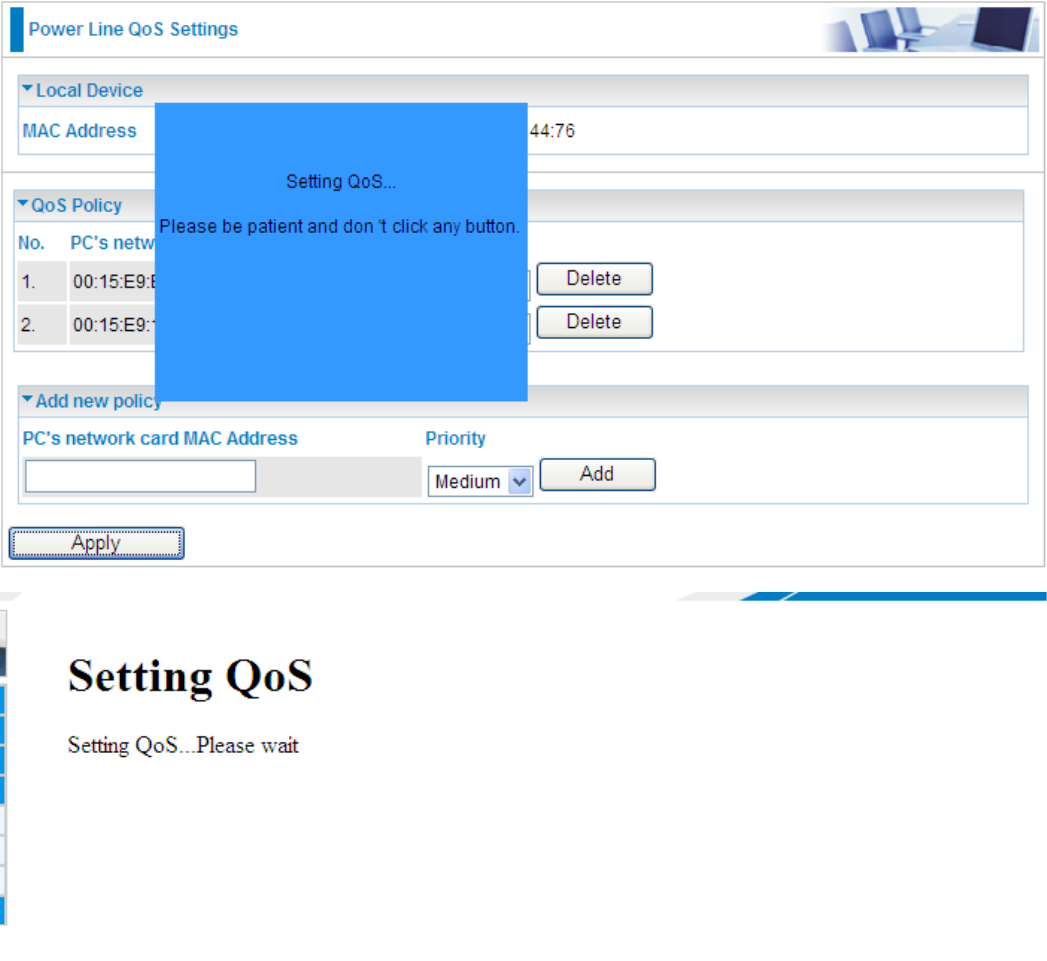
Click 5. Apply to conrm the conguration.
Note: Do NOT perform any more actions in QoS setting process.
Once the setting is complete, you will be returned to the Power Line QoS Settings page.6.
44

45
Administration
System Management
Administrator Settings
Account: You are allowed to set your own account name. Default is admin.
Password: You are allowed to set your own password. Default is admin.
Click Apply to save the changes.
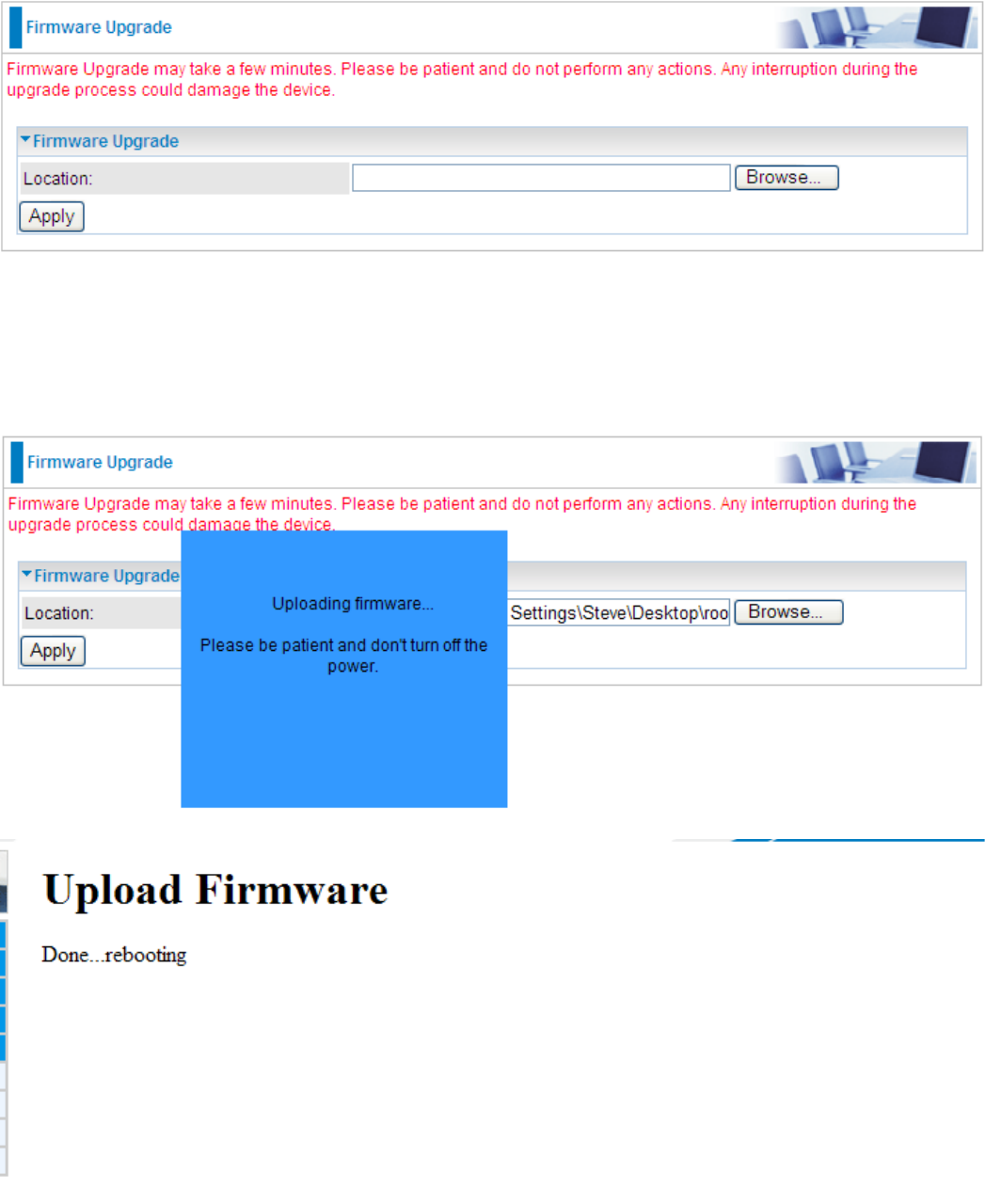
46
Firmware Upgrade
Upgrading the newly improved version of the rmware allows you to get the advantage to use
newly integrated features.
Update Firmware
Location: Click on Browse to select the new rmware image le you have downloaded to your
PC. Once the correct le is selected, click Apply to update the rmware to your device.
Note: Do NOT perform any more actions while the rmware is being upgraded.
The system will automatically reboot once the upgrade is complete. You will be returned to the
Status page.
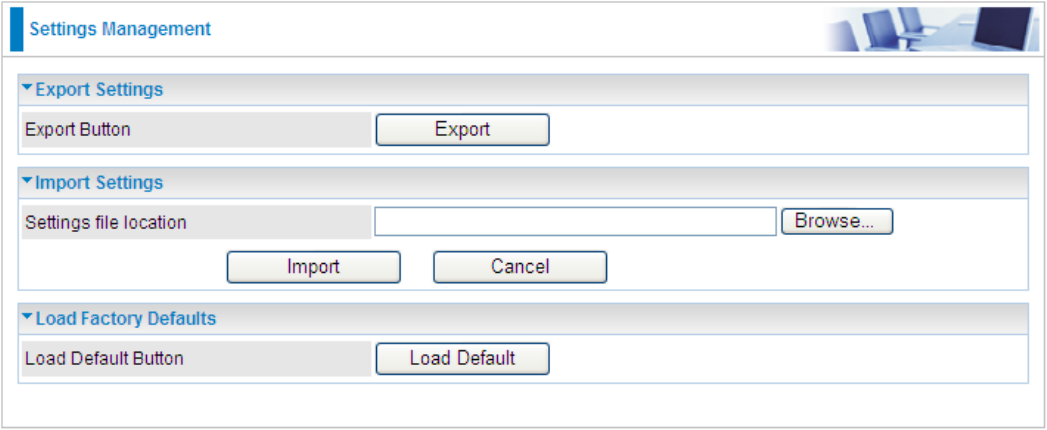
47
Settings Management
These functions allow you to save a backup of the current conguration of your device to a dened
location on your PC, to restore a previously saved conguration, or to restart your device with the
factory default settings. This is useful if you wish to experiment with different settings, knowing
that you have a backup in hand in case any mistakes occur. Besides, you can restart the device
to factory default setting after you have accidentally changed your settings that may result in
undesirable outcome.
Export Settings
Export Button: Click on Export to select where on your local PC you want to store your setting
le. You may also change the name of the le if you wish to keep multiple backups.
Note: It is advisable that you backup your device conguration before making any changes
to your device conguration.
Import Settings
Settings le location: Click on Browse to select a le from your PC to restore. You should only
restore your device setting that has been generated by the Backup function which is created with
the current version of the device rmware. Settings les saved to your PC should not be manually
edited in any way.
Select the settings les you wish to use, and press Import to load the setting into the device.
Load Factory Defaults
Load Default Button: Click on Load Default to initiate the reatart process. After restarting, please
wait several minutes to let the selected setting applied to the system.
You may also reset your device to factory settings by holding the small Reset pinhole button more
than 2 seconds.

48
Chapter 5: Troubleshooting
If your device is not functioning properly, please refer to the suggested solutions provided in this
chapter. If your problems persist or the suggested solutions do not meet your needs, please kindly
contact your service provider for support.
Problems with the device
Problem Suggested Solution
I forgot my password. First try entering the default user name and password:
User Name: admin; Password: admin. (Both the User Name and
Password are case sensitive, so make sure that CAPS LOCK is
not on when entering this information.)
If this fails, restore your HomePlug AV device to its factory
default settings and then enter the default user name and
password.
I can not access the LOGIN
Web Conguration Interface.
• Ensure you are using the correct IP address. (Default is
192.168.1.254.)
• Check the hardware connections and ensure all LEDs are
behaving as excepted.
• Ensure your computer’s IP address is in the same subnet as
the HomePlug device.
• Check to see if your browser has Java, JavaScript, or ActiveX
enabled. If you are using Internet Explorer, click Refresh to
ensure that the Java applet is loaded.
• Try closing the browser and re-launching it.
• Reset the device to factory defaults and try to acess the
HomePlug adapter with the default IP address.
How do I reset the
HomePlug AV200 adapter?
There are two ways to reset factory default settings:
• Hardware Reset
To perform a hardware reset, hold down the reset button for
more than 2 seconds, and release it.
• Software Reset
To initiate a software reset, select Administration > Settings
Mamagement and click on Load Default button to initiate the
reatart process. Then wait several minutes.
Note: Restoring to factory default will wipe out all the
congurations you have previously set. You are strongly
advised to create a backup copy of the settings before
resetting the device.
I can not start my HomePlug
device.
Please check your power supply is working. HomePlug device
operates from the power supplied by the home electrical wiring
and can not operate without a working power supply.
My HomePlug device is
unable to detect my other
HomePlug device.
This may due to the accidental change of the device password.
Access the HomePlug AV web interface and select Power Line
Settings > Privacy. Fill in the password (case sensitive) in the
blank. Then repeat the same procedure to the other HomePlug
device via Utility or web interface.